Robotic Systems for Hand Rehabilitation—Past, Present and Future
Abstract
:1. Introduction
2. Materials and Methods
2.1. Skeletal Model of the Human Hand
2.2. Motions of the Human Hand
2.3. Predominant Human Hand Postures
2.4. Data Extraction and Categorization
2.5. Literature Search and Selection
2.6. Data Analysis
2.7. Limitations
3. Hand Rehabilitation Devices
- Exoskeleton Devices
- End-Effector Devices
4. Exoskeleton Rehabilitation Devices
4.1. Classification by Type
4.1.1. Soft Exoskeletons
4.1.2. Rigid Exoskeletons
4.1.3. Hybrid Exoskeletons
4.2. Classification by Hand Mobility
4.3. Classification by Mechanism Position
4.3.1. Palmar
4.3.2. Lateral
4.3.3. Dorsal
4.3.4. Glove
4.4. Classification by Actuator Type
4.4.1. Electric Motors
4.4.2. Pneumatic Actuators
4.4.3. Shape Memory Alloys
4.4.4. Hydraulic Actuators
4.4.5. Human MUSCLE
4.4.6. Contralateral Extremity
4.4.7. Series Elastic Actuators
4.4.8. Other Types of Actuators
4.5. Classification by Transmission Type
4.5.1. Linkage
4.5.2. Gears
4.5.3. Cable
4.5.4. Restorative Springs
4.5.5. Compliant Transmission
5. Results and Discussion
5.1. Database Parameters Organization
5.2. Database Population Process
5.3. Limitations and Constraints
5.4. Discussions
6. Conclusions
Author Contributions
Funding
Institutional Review Board Statement
Informed Consent Statement
Data Availability Statement
Conflicts of Interest
References
- The Top 10 Causes of Death. Available online: https://www.who.int/news-room/fact-sheets/detail/the-top-10-causes-of-death (accessed on 9 November 2024).
- Murray, C.J.L.; Vos, T.; Lozano, R.; Naghavi, M.; Flaxman, A.D.; Michaud, C.; Ezzati, M.; Shibuya, K.; Salomon, J.A.; Abdalla, S.; et al. Disability-adjusted life years (DALYs) for 291 diseases and injuries in 21 regions, 1990–2010: A systematic analysis for the Global Burden of Disease Study 2010. Lancet 2012, 380, 2197–2223. [Google Scholar] [CrossRef] [PubMed]
- Major, Z.; Vaida, C.; Major, K.; Tucan, P.; Brusturean, E.; Gherman, B.; Birlescu, I.; Craciunas, R.; Ulinici, I.; Simori, G.; et al. Comparative Assessment of Robotic versus Classical Physical Therapy Using Muscle Strength and Ranges of Motion Testing in Neurological Diseases. J. Pers. Med. 2021, 11, 953. [Google Scholar] [CrossRef]
- Wafa, H.A.; Wolfe, C.D.A.; Emmett, E.; Roth, G.A.; Johnson, C.O.; Wang, Y. Burden of Stroke in Europe: Thirty-Year Projections of Incidence, Prevalence, Deaths, and Disability-Adjusted Life Years. Stroke 2020, 51, 2418–2427. [Google Scholar] [CrossRef] [PubMed]
- Vaida, C.; Carbone, G.; Major, K.A.; Major, Z.; Plitea, N.; Pisla, D. On Human Robot Interaction Modalities in the Upper Limb Rehabilitation After Stroke. Acta Tech. Napoc. Ser. Appl. Math. Mech. Eng. 2017, 60, 91–102. [Google Scholar]
- Yang, Y.; Wang, G.; Zhang, S.; Wang, H.; Zhou, W.; Ren, F.F.; Liang, H.; Wu, D.D.; Ji, X.Y.; Hashimoto, M.; et al. Efficacy and evaluation of therapeutic exercises on adults with Parkinson’s disease: A systematic review and network meta-analysis. BMC Geriatr. 2022, 22, 813. [Google Scholar] [CrossRef]
- Selph, S.S.; Skelly, A.C.; Wasson, N.; Dettori, J.R.; Brodt, E.D.; Ensrud, E.; Elliot, D.; Dissinger, K.M.; McDonagh, M. Physical Activity and the Health of Wheelchair Users: A Systematic Review in Multiple Sclerosis, Cerebral Palsy, and Spinal Cord Injury. Arch. Phys. Med. Rehabil. 2021, 102, 2464–2481. [Google Scholar] [CrossRef] [PubMed]
- McKevitt, C.; Fudge, N.; Redfern, J.; Sheldenkar, A.; Crichton, S.; Rudd, A.R.; Forster, A.; Young, J.; Nazareth, I.; Silver, L.E.; et al. Self-reported long-term needs after stroke. Stroke 2011, 42, 1398–1403. [Google Scholar] [CrossRef]
- Wolfe, C.D.A.; Crichton, S.L.; Heuschmann, P.U.; McKevitt, C.J.; Toschke, A.M.; Grieve, A.P.; Rudd, A.G. Estimates of outcomes up to ten years after stroke: Analysis from the prospective South London Stroke Register. PLoS Med. 2011, 8, e1001033. [Google Scholar] [CrossRef] [PubMed]
- The Burden of Stroke in Europe Report; King’s College London for the Stroke Alliance for Europe: London, UK, 2019; ISBN 978-1-5272-0858-2.
- Li, S. Spasticity, Motor Recovery, and Neural Plasticity after Stroke. Front. Neurol. 2017, 8, 120. [Google Scholar] [CrossRef] [PubMed]
- Sommerfeld, D.K.; Eek, E.U.-B.; Svensson, A.-K.; Holmqvist, L.W.; von Arbin, M.H. Spasticity After Stroke: Its Occurrence and Association With Motor Impairments and Activity Limitations. Stroke 2004, 35, 134–139. [Google Scholar] [CrossRef]
- Worsnopp, T.T.; Peshkin, M.A.; Colgate, J.E.; Kamper, D.G. An Actuated Finger Exoskeleton for Hand Rehabilitation Following Stroke. In Proceedings of the IEEE 10th International Conference on Rehabilitation Robotics, Noordwijk, The Netherlands, 13–15 June 2007; pp. 896–901. [Google Scholar] [CrossRef]
- Demarin, V.; Morovic, S.; Béné, R. Neuroplasticity. Period. Biol. 2014, 116, 209–211. [Google Scholar]
- Alhamad, R.; Seth, N.; Abdullah, H. Initial Testing of Robotic Exoskeleton Hand Device for Stroke Rehabilitation. Sensors 2023, 23, 6339. [Google Scholar] [CrossRef]
- Su, Y.S.; Veeravagu, A.; Grant, G. Neuroplasticity after Traumatic Brain Injury. In Translational Research in Traumatic Brain Injury; Laskowitz, D., Grant, G., Eds.; CRC Press/Taylor and Francis Group: Boca Raton, FL, USA, 2016; Chapter 8. [Google Scholar]
- Nahmani, M.; Turrigiano, G. Adult Cortical Plasticity Following Injury: Recapitulation of Critical Period Mechanisms? Neuroscience 2014, 283, 4–16. [Google Scholar] [CrossRef] [PubMed]
- Carmichael, S.T. Plasticity of Cortical Projections after Stroke. Neuroscientist 2003, 9, 64–75. [Google Scholar] [CrossRef]
- Keci, A.; Tani, K.; Xhema, J. Role of Rehabilitation in Neural Plasticity. Open Access Maced. J. Med. Sci. 2019, 7, 1540–1547. [Google Scholar] [CrossRef] [PubMed]
- Kleim, J.A. Neural Plasticity and Neurorehabilitation: Teaching the New Brain Old Tricks. J. Commun. Disord. 2011, 44, 521–528. [Google Scholar] [CrossRef]
- Pisla, D.; Tarnita, D.; Tucan, P.; Tohanean, N.; Vaida, C.; Geonea, I.D.; Bogdan, G.; Abrudan, C.; Carbone, G.; Plitea, N. A Parallel Robot with Torque Monitoring for Brachial Monoparesis Rehabilitation Tasks. Appl. Sci. 2021, 11, 9932. [Google Scholar] [CrossRef]
- Kabir, R.; Sunny, M.S.H.; Ahmed, H.U.; Rahman, M.H. Hand Rehabilitation Devices: A Comprehensive Systematic Review. Micromachines 2022, 13, 1033. [Google Scholar] [CrossRef]
- Langhorne, P.; Bernhardt, J.; Kwakkel, G. Stroke Rehabilitation. Lancet 2011, 377, 1693–1702. [Google Scholar] [CrossRef]
- Maceira-Elvira, P.; Popa, T.; Schmid, A.C.; Hummel, F.C. Wearable Technology in Stroke Rehabilitation: Towards Improved Diagnosis and Treatment of Upper-Limb Motor Impairment. J. Neuroeng. Rehabil. 2019, 16, 142. [Google Scholar] [CrossRef] [PubMed]
- Teasell, R.; Salbach, N.M.; Foley, N.; Mountain, A.; Cameron, J.I.; Jong, A.; Acerra, N.E.; Bastasi, D.; Carter, S.L.; Fung, J.; et al. Canadian Stroke Best Practice Recommendations: Rehabilitation, Recovery, and Community Participation following Stroke. Part One: Rehabilitation and Recovery Following Stroke; 6th Edition Update 2019. Int. J. Stroke 2020, 15, 763–788. [Google Scholar] [CrossRef]
- Orthopedic Associates of Hartford. Hand Home Exercises. Available online: https://oahct.com/wp-content/uploads/2020/05/OAH-HAND-EXERCISES.pdf (accessed on 9 November 2024).
- Peveler, R.; Carson, A.; Rodin, G. ABC of Psychological Medicine: Depression in Medical Patients. BMJ 2002, 325, 149–152. Available online: http://www.jstor.org/stable/25451876 (accessed on 14 November 2024). [CrossRef]
- Edwards, D.J. On the Understanding and Development of Modern Physical Neurorehabilitation Methods: Robotics and Non-Invasive Brain Stimulation. J. Neuroeng. Rehabil. 2009, 6, 3. [Google Scholar] [CrossRef]
- Major, Z.Z.; Vaida, C.; Major, K.A.; Tucan, P.; Simori, G.; Banica, A.; Brusturean, E.; Burz, A.; Craciunas, R.; Ulinici, I.; et al. The Impact of Robotic Rehabilitation on the Motor System in Neurological Diseases. A Multimodal Neurophysiological Approach. Int. J. Environ. Res. Public Health 2020, 17, 6557. [Google Scholar] [CrossRef]
- Plitea, N.; Hesselbach, J.; Pisla, D.; Raatz, A.; Vaida, C.; Wrege, J.; Burisch, A. Innovative Development of Parallel Robots and Microrobots. Acta Teh. Napoc. Ser. Appl. Math. Mec. 2006, 49, 5–26. [Google Scholar]
- Pisla, D.; Nadas, I.; Tucan, P.; Albert, S.; Carbone, G.; Antal, T.; Banica, A.; Gherman, B. Development of a Control System and Functional Validation of a Parallel Robot for Lower Limb Rehabilitation. Actuators 2021, 10, 277. [Google Scholar] [CrossRef]
- Yue, Z.; Zhang, X.; Wang, J. Hand Rehabilitation Robotics on Poststroke Motor Recovery. Behav. Neurol. 2017, 2017, 3908135. [Google Scholar] [CrossRef]
- Feine, J.S.; Widmer, C.G.; Lund, J.P. Physical Therapy: A Critique. Oral Surg. Oral Med. Oral Pathol. Oral Radiol. Endod. 1997, 83, 123–127. [Google Scholar] [CrossRef]
- Landry, M.D.; Hack, L.M.; Coulson, E.; Freburger, J.; Johnson, M.P.; Katz, R.; Kerwin, J.; Smith, M.H.; Wessman, H.C.; Venskus, D.G.; et al. Workforce Projections 2010–2020: Annual Supply and Demand Forecasting Models for Physical Therapists Across the United States. Phys. Ther. 2016, 96, 71–80. [Google Scholar] [CrossRef]
- Marek, K.; Redlicka, J.; Miller, E.; Zubrycki, I. Objectivizing Measures of Post-Stroke Hand Rehabilitation Through Multi-Disciplinary Scales. J. Clin. Med. 2023, 12, 7497. [Google Scholar] [CrossRef]
- Gustafsson, L.A.; Turpin, M.J.; Dorman, C.M. Clinical Utility of the Chedoke Arm and Hand Activity Inventory for Stroke Rehabilitation. Can. J. Occup. Ther. 2010, 77, 167–173. [Google Scholar] [CrossRef] [PubMed]
- Ikbali Afsar, S.; Mirzayev, I.; Umit Yemisci, O.; Cosar Saracgil, S.N. Virtual Reality in Upper Extremity Rehabilitation of Stroke Patients: A Randomized Controlled Trial. J. Stroke Cerebrovasc. Dis. 2018, 27, 3473–3478. [Google Scholar] [CrossRef] [PubMed]
- Oliveira, C.S.; Almeida, C.S.; Freitas, L.C.; Santana, R.; Fernandes, G.; Fonseca Junior, P.R.; Moura, R.C.F. Use of the Box and Block Test for the Evaluation of Manual Dexterity in Individuals with Central Nervous System Disorders: A Systematic Review. Man. Ther. Posturology Rehabil. J. 2016, 14, 436. [Google Scholar] [CrossRef]
- Solaro, C.; Di Giovanni, R.; Grange, E.; Mueller, M.; Messmer Uccelli, M.; Bertoni, R.; Brichetto, G.; Tacchino, A.; Patti, F.; Pappalardo, A.; et al. Box and Block Test, Hand Grip Strength and Nine-Hole Peg Test: Correlations Between Three Upper Limb Objective Measures in Multiple Sclerosis. Eur. J. Neurol. 2020, 27, 2523–2530. [Google Scholar] [CrossRef]
- Beebe, J.A.; Lang, C.E. Relationships and Responsiveness of Six Upper Extremity Function Tests During the First Six Months of Recovery After Stroke. J. Neurol. Phys. Ther. 2009, 33, 96–103. [Google Scholar] [CrossRef]
- Moreno-Morente, G.; Hurtado-Pomares, M.; Terol Cantero, M.C. Bibliometric Analysis of Research on the Use of the Nine Hole Peg Test. Int. J. Environ. Res. Public Health 2022, 19, 10080. [Google Scholar] [CrossRef]
- Krumlinde-Sundholm, L.; Lindkvist, B.; Plantin, J.; Hoare, B. Development of the Assisting Hand Assessment for Adults Following Stroke: A Rasch-Built Bimanual Performance Measure. Disabil. Rehabil. 2019, 41, 472–480. [Google Scholar] [CrossRef]
- Brunnstrom, S. Motor Testing Procedures in Hemiplegia: Based on Sequential Recovery Stages. Phys. Ther. 1966, 46, 357–375. [Google Scholar] [CrossRef] [PubMed]
- Arwert, H.; Schut, S.; Boiten, J.; Vliet Vlieland, T.; Meesters, J. Patient Reported Outcomes of Hand Function Three Years After Stroke. Top. Stroke Rehabil. 2018, 25, 13–19. [Google Scholar] [CrossRef] [PubMed]
- Arcidiacone, S.; Panuccio, F.; Tusoni, F.; Galeoto, G. A Systematic Review of the Measurement Properties of the Michigan Hand Outcomes Questionnaire (MHQ). Hand Surg. Rehabil. 2022, 41, 542–551. [Google Scholar] [CrossRef]
- Jebsen, R.H.; Taylor, N.; Trieschmann, R.B.; Trotter, M.J.; Howard, L.A. An Objective and Standardized Test of Hand Function. Arch. Phys. Med. Rehabil. 1969, 50, 311–319. [Google Scholar]
- Resnik, L.; Adams, L.; Borgia, M.; Delikat, J.; Disla, R.; Ebner, C.; Walters, L.S. Development and Evaluation of the Activities Measure for Upper Limb Amputees. Arch. Phys. Med. Rehabil. 2013, 94, 488–494.e4. [Google Scholar] [CrossRef] [PubMed]
- Sezer, N.; Yavuzer, G.; Sivrioglu, K.; Basaran, P.; Koseoglu, B.F. Clinimetric Properties of the Duruoz Hand Index in Patients with Stroke. Arch. Phys. Med. Rehabil. 2007, 88, 309–314. [Google Scholar] [CrossRef]
- Duruöz, M.T.; Poiraudeau, S.; Fermanian, J.; Menkes, C.J.; Amor, B.; Dougados, M.; Revel, M. Development and Validation of a Rheumatoid Hand Functional Disability Scale that Assesses Functional Handicap. J. Rheumatol. 1996, 23, 1167–1172. [Google Scholar]
- Lefevre-Colau, M.M.; Poiraudeau, S.; Fermanian, J.; Etchepare, F.; Alnot, J.Y.; Le Viet, D.; Leclercq, C.; Oberlin, C.; Bargy, F.; Revel, M. Responsiveness of the Cochin Rheumatoid Hand Disability Scale After Surgery. Rheumatology 2001, 40, 843–850. [Google Scholar] [CrossRef]
- Brower, L.M.; Poole, J.L. Reliability and Validity of the Duruoz Hand Index in Persons with Systemic Sclerosis (Scleroderma). Arthritis Rheum. 2004, 51, 805–809. [Google Scholar] [CrossRef]
- Duruöz, M.T.; Cerrahoglu, L.; Dincer-Turhan, Y.; Kürsat, S. Hand Function Assessment in Patients Receiving Haemodialysis. Swiss Med. Wkly. 2003, 133, 433–438. [Google Scholar] [CrossRef]
- Penta, M.; Tesio, L.; Arnould, C.; Zancan, A.; Thonnard, J.L. The ABILHAND Questionnaire as a Measure of Manual Ability in Chronic Stroke Patients: Rasch-Based Validation and Relationship to Upper Limb Impairment. Stroke 2001, 32, 1627–1634. [Google Scholar] [CrossRef] [PubMed]
- Ekstrand, E.; Alt Murphy, M.; Sunnerhagen, K.S. Clinical Interpretation and Cutoff Scores for Manual Ability Measured by the ABILHAND Questionnaire in People with Stroke. Top. Stroke Rehabil. 2023, 30, 21–31. [Google Scholar] [CrossRef] [PubMed]
- Alt Murphy, M.; Resteghini, C.; Feys, P.; Lamers, I. An Overview of Systematic Reviews on Upper Extremity Outcome Measures After Stroke. BMC Neurol. 2015, 15, 29. [Google Scholar] [CrossRef]
- Mordor Intelligence. Rehabilitation Robots Market|2022-27|Industry Share, Size, Growth. Available online: https://www.mordorintelligence.com/industry-reports/rehabilitation-robots-market (accessed on 9 November 2024).
- Fortune Business Insights. Rehabilitation Robots Market Size, Share|Global Analysis 2026. Available online: https://www.fortunebusinessinsights.com/industry-reports/rehabilitation-robots-market-101013 (accessed on 9 November 2024).
- Ghosh, S. Capturing Human Hand Kinematics for Object Grasping and Manipulation. Master’s Thesis, Texas A&M University, College Station, TX, USA, May 2013. Available online: https://oaktrust.library.tamu.edu/items/e966525a-6fa2-4a93-a4e0-7bea33c725ee (accessed on 9 November 2024).
- Xia, K.; Chen, X.; Chang, X.; Liu, C.; Guo, L.; Xu, X.; Lv, F.; Wang, Y.; Sun, H.; Zhou, J. Hand Exoskeleton Design and Human–Machine Interaction Strategies for Rehabilitation. Bioengineering 2022, 9, 682. [Google Scholar] [CrossRef]
- Suarez-Escobar, M.; Rendon-Velez, E. An Overview of Robotic/Mechanical Devices for Post-Stroke Thumb Rehabilitation. Disabil. Rehabil. Assist. Technol. 2018, 13, 683–703. [Google Scholar] [CrossRef] [PubMed]
- Wang, L.; Meydan, T.; Williams, P.I. A Two-Axis Goniometric Sensor for Tracking Finger Motion. Sensors 2017, 17, 770. [Google Scholar] [CrossRef] [PubMed]
- Jarque-Bou, N.J.; Atzori, M.; Müller, H. A Large Calibrated Database of Hand Movements and Grasps Kinematics. Sci. Data 2020, 7, 12. [Google Scholar] [CrossRef] [PubMed]
- Iqbal, J.; Baizid, K. Stroke rehabilitation using exoskeleton-based robotic exercisers: Mini Review. Biomed. Res. India 2014, 26, 197–201. [Google Scholar]
- Heo, P.; Gu, G.M.; Lee, S.; Rhee, K.; Kim, J. Current Hand Exoskeleton Technologies for Rehabilitation and Assistive Engineering. Int. J. Precis. Eng. Manuf. 2012, 13, 807–824. [Google Scholar] [CrossRef]
- Vaida, C.; Birlescu, I.; Pisla, A.; Carbone, G.; Plitea, N.; Ulinici, I.; Gherman, B.; Puskas, F.; Tucan, P.; Pisla, D. RAISE—An Innovative Parallel Robotic System for Lower Limb Rehabilitation. Adv. Theory Pract. 2019, 4, 293–302. [Google Scholar] [CrossRef]
- Pisla, D.; Plitea, N.; Gherman, B.; Pisla, A.; Vaida, C. Kinematical Analysis and Design of a New Surgical Parallel Robot. In Computational Kinematics; Kecskeméthy, A., Müller, A., Eds.; Springer: Berlin/Heidelberg, Germany, 2009. [Google Scholar] [CrossRef]
- Vaida, C.; Plitea, N.; Carbone, G.; Birlescu, I.; Ulinici, I.; Pisla, A.; Pisla, D. Innovative Development of a Spherical Parallel Robot for Upper Limb Rehabilitation. Int. J. Mech. Robot. Syst. 2018, 4, 256. [Google Scholar] [CrossRef]
- Brewer, B.R.; McDowell, S.K.; Worthen-Chaudhari, L.C. Poststroke upper extremity rehabilitation: A review of robotic systems and clinical results. Top. Stroke Rehabil. 2007, 14, 22–44. [Google Scholar] [CrossRef]
- Gopura, R.A.R.C.; Bandara, D.S.V.; Kiguchi, K.; Mann, G.K.I. Developments in hardware systems of active upper-limb exoskeleton robots: A review. Robot. Auton. Syst. 2016, 75, 203–220. [Google Scholar] [CrossRef]
- Krebs, H.I.; Hogan, N.; Aisen, M.L.; Volpe, B.T. Robot-aided neurorehabilitation. IEEE Trans. Rehabil. Eng. 1998, 6, 75–87. [Google Scholar] [CrossRef]
- Todorov, E.; Shadmehr, R.; Bizzi, E. Augmented Feedback Presented in a Virtual Environment Accelerates Learning of a Difficult Motor Task. J. Mot. Behav. 1997, 29, 147–158. [Google Scholar] [CrossRef]
- Sarac, M.; Solazzi, M.; Frisoli, A. Design Requirements of Generic Hand Exoskeletons and Survey of Hand Exoskeletons for Rehabilitation, Assistive, or Haptic Use. IEEE Trans. Haptics 2019, 12, 400–413. [Google Scholar] [CrossRef] [PubMed]
- Choi, I.; Hawkes, E.; Christensen, D.; Ploch, C.; Follmer, S. Wolverine: A wearable haptic interface for grasping in virtual reality. In Proceedings of the IEEE/RSJ International Conference on Intelligent Robots and Systems (IROS), Daejeon, Republic of Korea, 9–14 October 2016; pp. 986–993. [Google Scholar] [CrossRef]
- Buchholz, B.; Armstrong, T.J. A Kinematic Model of the Human Hand to Evaluate Its Prehensile Capabilities. J. Biomech. 1992, 25, 149–162. [Google Scholar] [CrossRef] [PubMed]
- Aggogeri, F.; Mikolajczyk, T.; O’Kane, J. Robotics for Rehabilitation of Hand Movement in Stroke Survivors. Adv. Mech. Eng. 2019, 11, 168781401984192. [Google Scholar] [CrossRef]
- Achilli, G.M.; Amici, C.; Dragusanu, M.; Gobbo, M.; Logozzo, S.; Malvezzi, M.; Tiboni, M.; Valigi, M.C. Soft, Rigid, and Hybrid Robotic Exoskeletons for Hand Rehabilitation: Roadmap with Impairment-Oriented Rationale for Devices Design and Selection. Appl. Sci. 2023, 13, 11287. [Google Scholar] [CrossRef]
- Tiboni, M.; Amici, C. Soft Gloves: A Review on Recent Developments in Actuation, Sensing, Control and Applications. Actuators 2022, 11, 232. [Google Scholar] [CrossRef]
- Shahid, T.; Gouwanda, D.; Nurzaman, S.G.; Gopalai, A.A. Moving Toward Soft Robotics: A Decade Review of the Design of Hand Exoskeletons. Biomimetics 2018, 3, 17. [Google Scholar] [CrossRef]
- Kang, B.B.; In, H.; Cho, K. Force Transmission in Joint-less Tendon Driven Wearable Robotic Hand. In Proceedings of the 2012 12th International Conference on Control, Automation and Systems, Jeju Island, Republic of Korea, 17–21 October 2012; pp. 1853–1858. [Google Scholar]
- Noronha, B.; Accoto, D. Exoskeletal Devices for Hand Assistance and Rehabilitation: A Comprehensive Analysis of State-of-the-Art Technologies. IEEE Trans. Med. Robot. Bionics 2021, 3, 525–538. [Google Scholar] [CrossRef]
- Zong, G.; Pei, X.; Yu, J.; Bi, S. Classification and Type Synthesis of 1-DOF Remote Center of Motion Mechanisms. Mech. Mach. Theory 2008, 43, 1585–1595. [Google Scholar] [CrossRef]
- Ferguson, P.W.; Shen, Y.; Rosen, J. Hand Exoskeleton Systems—Overview. In Wearable Robotics; Rosen, J., Ferguson, P.W., Eds.; Academic Press: Cambridge, MA, USA, 2020; pp. 149–175. [Google Scholar] [CrossRef]
- Nava-Téllez, I.A.; Elias-Espinosa, M.C.; Cervantes-Culebro, H.; Flores-González, A.E. Parametric Design of a Finger Rehabilitation Mechanism with Double Action and Two Degrees of Freedom. Appl. Sci. 2022, 12, 10701. [Google Scholar] [CrossRef]
- Esposito, D.; Centracchio, J.; Andreozzi, E.; Savino, S.; Gargiulo, G.D.; Naik, G.R.; Bifulco, P. Design of a 3D-Printed Hand Exoskeleton Based on Force-Myography Control for Assistance and Rehabilitation. Machines 2022, 10, 57. [Google Scholar] [CrossRef]
- Hsu, T.-H.; Chiang, Y.-C.; Chan, W.-T.; Chen, S.-J. A Finger Exoskeleton Robot for Finger Movement Rehabilitation. Inventions 2017, 2, 12. [Google Scholar] [CrossRef]
- Dickmann, T.; Wilhelm, N.J.; Glowalla, C.; Haddadin, S.; van der Smagt, P.; Burgkart, R. An Adaptive Mechatronic Exoskeleton for Force-Controlled Finger Rehabilitation. Front. Robot. AI 2021, 8, 716451. [Google Scholar] [CrossRef] [PubMed]
- Troncossi, M.; Mozaffari Foumashi, M.; Carricato, M.; Parenti Castelli, V. Feasibility Study of a Hand Exoskeleton for Rehabilitation of Post-Stroke Patients. In Proceedings of the ASME 2012 International Design Engineering Technical Conferences and Computers and Information in Engineering Conference, Nantes, France, 2–4 July 2012; pp. 137–146. [Google Scholar] [CrossRef]
- Wu, J.; Huang, J.; Wang, Y.; Xing, K. A Wearable Rehabilitation Robotic Hand Driven by PM-TS Actuators. In Proceedings of the International Conference on Intelligent Robotics and Applications (ICIRA), Shanghai, China, 10–12 November 2010; pp. 440–450. [Google Scholar] [CrossRef]
- Wei, W.; Guo, S.; Zhang, F.; Guo, J.; Ji, Y.; Wang, Y. A Novel Upper Limb Rehabilitation System with Hand Exoskeleton Mechanism. In Proceedings of the 2013 IEEE International Conference on Mechatronics and Automation, Takamatsu, Japan, 4–7 August 2013; pp. 285–290. [Google Scholar]
- Gasser, B.W.; Goldfarb, M. Design and Performance Characterization of a Hand Orthosis Prototype to Aid Activities of Daily Living in a Post-Stroke Population. In Proceedings of the 37th Annual International Conference of the IEEE Engineering in Medicine and Biology Society, Milan, Italy, 25–29 August 2015; pp. 3877–3880. [Google Scholar] [CrossRef]
- Lince, A.; Celadon, N.; Battezzato, A.; Favetto, A.; Appendino, S.; Ariano, P.; Botta, A.M. Design and Testing of an Under-Actuated Surface EMG-Driven Hand Exoskeleton. In Proceedings of the 2017 International Conference on Rehabilitation Robotics (ICORR), London, UK, 17–20 July 2017; pp. 670–675. [Google Scholar] [CrossRef]
- Gosselin, F.; Jouan, T.; Brisset, J.; Andriot, C. Design of a Wearable Haptic Interface for Precise Finger Interactions in Large Virtual Environments. In Proceedings of the First Joint Eurohaptics Conference and Symposium on Haptic Interfaces for Virtual Environment and Teleoperator Systems, Pisa, Italy, 18–20 March 2005; pp. 202–207. [Google Scholar] [CrossRef]
- Ben-Tzvi, P.; Ma, Z. Sensing and force-feedback exoskeleton (SAFE) robotic glove. IEEE Trans. Neural Syst. Rehabil. Eng. 2015, 23, 992–1002. [Google Scholar] [CrossRef]
- Fang, H.; Xie, Z.; Liu, H. An Exoskeleton Master Hand for Controlling DLR/HIT Hand. In Proceedings of the 2009 IEEE/RSJ International Conference on Intelligent Robots and Systems, St. Louis, MO, USA, 10–15 October 2009; pp. 3703–3708. [Google Scholar] [CrossRef]
- Iqbal, J.; Tsagarakis, N.G.; Caldwell, D.G. A Multi-DOF Robotic Exoskeleton Interface for Hand Motion Assistance. In Proceedings of the 33rd Annual International Conference of the IEEE Engineering in Medicine and Biology Society, Boston, MA, USA, 30 August–3 September 2011; pp. 1575–1578. [Google Scholar] [CrossRef]
- Sarakoglou, I.; Brygo, A.; Mazzanti, D.; Hernandez, N.G.; Caldwell, D.G.; Tsagarakis, N.G. HEXOTRAC: A highly under-actuated hand exoskeleton for finger tracking and force feedback. In Proceedings of the 2016 IEEE/RSJ International Conference on Intelligent Robots and Systems (IROS), Daejeon, Republic of Korea, 9–14 October 2016; pp. 1033–1040. [Google Scholar] [CrossRef]
- Ertas, I.H.; Hocaoglu, E.; Barkana, D.E.; Patoglu, V. Finger exoskeleton for treatment of tendon injuries. In Proceedings of the 2009 IEEE International Conference on Rehabilitation Robotics (ICORR), Kyoto, Japan, 23–26 June 2009; pp. 194–201. [Google Scholar] [CrossRef]
- Sarac, M.; Solazzi, M.; Sotgiu, E.; Bergamasco, M.; Frisoli, A. Design and kinematic optimization of a novel underactuated robotic hand exoskeleton. Meccanica 2017, 52, 749–761. [Google Scholar] [CrossRef]
- Buryanov, A.; Kotiuk, V. Proportions of Hand Segments. Int. J. Morphol. 2010, 28, 755–758. [Google Scholar] [CrossRef]
- Jarrasse, N.; Morel, G. Connecting a Human Limb to an Exoskeleton. IEEE Trans. Robot. 2012, 28, 697–709. [Google Scholar] [CrossRef]
- Tang, Z.J.; Sugano, S.; Iwata, H. A novel, MRI compatible hand exoskeleton for finger rehabilitation. In Proceedings of the 2011 IEEE/SICE International Symposium on System Integration (SII), Kyoto, Japan, 20–22 December 2011; pp. 118–123. [Google Scholar] [CrossRef]
- DiCicco, M.; Lucas, L.; Matsuoka, Y. Comparison of control strategies for an EMG controlled orthotic exoskeleton for the hand. In Proceedings of the 2004 IEEE International Conference on Robotics and Automation (ICRA), New Orleans, LA, USA, 26 April–1 May 2004; pp. 1622–1627. [Google Scholar] [CrossRef]
- Cempini, M.; Cortese, M.; Vitiello, N.; Giovacchini, F.; Moise, M.; Posteraro, F.; Carrozza, M.C. Kinematics and design of a portable and wearable exoskeleton for hand rehabilitation. In Proceedings of the 2013 IEEE 13th International Conference on Rehabilitation Robotics (ICORR), Seattle, WA, USA, 24–26 June 2013; pp. 1–6. [Google Scholar] [CrossRef]
- Rahman, M.A.; Al-Jumaily, A. Design and Development of a Hand Exoskeleton for Rehabilitation Following Stroke. In Proceedings of the 2012 International Conference on Biomedical Engineering (ICBE), Penang, Malaysia, 27–28 February 2012; pp. 1705–1710. [Google Scholar] [CrossRef]
- Lu, X.; Yang, Z.; Chen, Y.; Wang, J. Structure Design of a Wearable Device for Hand Rehabilitation. In Proceedings of the 2016 9th International Symposium on Computational Intelligence and Design (ISCID), Hangzhou, China, 10–11 December 2016; pp. 93–96. [Google Scholar] [CrossRef]
- Guo, S.; Zhang, W.; Guo, J.; Gao, J.; Hu, Y. Design and kinematic simulation of a novel exoskeleton rehabilitation hand robot. In Proceedings of the 2016 IEEE International Conference on Mechatronics and Automation (ICMA), Harbin, China, 7–10 August 2016; pp. 1125–1130. [Google Scholar] [CrossRef]
- Yamaura, H.; Matsushita, K.; Kato, R.; Yokoi, H. Development of hand rehabilitation system for paralysis patient—Universal design using wire-driven mechanism. In Proceedings of the 2009 Annual International Conference of the IEEE Engineering in Medicine and Biology Society, Minneapolis, MN, USA, 3–6 September 2009; pp. 7122–7125. [Google Scholar] [CrossRef]
- Fontana, M.; Dettori, A.; Salsedo, F.; Bergamasco, M. Mechanical design of a novel Hand Exoskeleton for accurate force displaying. In Proceedings of the 2009 IEEE International Conference on Robotics and Automation (ICRA), Kobe, Japan, 12–17 May 2009; pp. 1704–1709. [Google Scholar] [CrossRef]
- Burton, T.M.W.; Vaidyanathan, R.; Burgess, S.C.; Turton, A.J.; Melhuish, C. Development of a parametric kinematic model of the human hand and a novel robotic exoskeleton. In Proceedings of the 2011 IEEE International Conference on Rehabilitation Robotics (ICORR), Zurich, Switzerland, 29 June–1 July 2011; pp. 1–7. [Google Scholar] [CrossRef]
- Wei, Q.; Yang, C.; Bi, Q.; Yang, W. A Grasp Strategy with Flexible Contacting for Multi-fingered Hand Rehabilitation Exoskeleton. In Wearable Sensors and Robots; Yang, C., Virk, G., Yang, H., Eds.; Lecture Notes in Electrical Engineering; Springer: Singapore, 2017; Volume 399. [Google Scholar] [CrossRef]
- Agarwal, P.; Deshpande, A.D. Impedance and force-field control of the index finger module of a hand exoskeleton for rehabilitation. In Proceedings of the 2015 IEEE International Conference on Rehabilitation Robotics (ICORR), Singapore, 11–14 August 2015; pp. 85–90. [Google Scholar] [CrossRef]
- Arata, J.; Ohmoto, K.; Gassert, R.; Lambercy, O.; Fujimoto, H.; Wada, I. A new hand exoskeleton device for rehabilitation using a three-layered sliding spring mechanism. In Proceedings of the 2013 IEEE International Conference on Robotics and Automation (ICRA), Karlsruhe, Germany, 6–10 May 2013; pp. 3902–3907. [Google Scholar] [CrossRef]
- Tiboni, M.; Borboni, A.; Vérité, F.; Bregoli, C.; Amici, C. Sensors and Actuation Technologies in Exoskeletons: A Review. Sensors 2022, 22, 884. [Google Scholar] [CrossRef]
- Lin, L.; Zhang, F.; Yang, L.; Fu, Y. Design and Modeling of a Hybrid Soft-Rigid Hand Exoskeleton for Poststroke Rehabilitation. Int. J. Mech. Sci. 2021, 209, 106831. [Google Scholar] [CrossRef]
- Achilli, G.M.; Logozzo, S.; Valigi, M.C.; Dragusanu, M.; Malvezzi, M. Theoretical and Experimental Characterization of a New Robotic gripper’s Joint. In Advances in Italian Mechanism Science; Niola, V., Gasparetto, A., Quaglia, G., Carbone, G., Eds.; Mechanisms and Machine Science; Springer: Cham, Switzerland, 2022; Volume 122. [Google Scholar] [CrossRef]
- Li, M.; Xu, G.; Xie, J.; Chen, C. A Soft Robotic Glove for Hand Rehabilitation Training Controlled by Movements of the Healthy Hand. In Proceedings of the International Conference on Ubiquitous Robots (UR), Kyoto, Japan, 24–27 June 2020; pp. 62–67. [Google Scholar] [CrossRef]
- Serbest, K.; Eldoğan, O. Design, Development and Evaluation of a New Hand Exoskeleton for Stroke Rehabilitation at Home. Politeknik Derg. 2021, 24, 305–314. [Google Scholar] [CrossRef]
- Li, G.; Cheng, L.; Sun, N. Design, manipulability analysis and optimization of an index finger exoskeleton for stroke rehabilitation. Mech. Mach. Theory 2022, 167, 104526. [Google Scholar] [CrossRef]
- Bützer, T.; Lambercy, O.; Arata, J.; Gassert, R. Fully wearable actuated soft exoskeleton for grasping assistance in everyday activities. Soft Robot. 2021, 8, 128–143. [Google Scholar] [CrossRef]
- Vertongen, J.; Kamper, D. Design of a 3D printed hybrid mechanical structure for a hand exoskeleton. Curr. Dir. Biomed. Eng. 2020, 6, 20202003. [Google Scholar] [CrossRef]
- Wang, Z.; Wang, D.; Zhang, Y.; Liu, J.; Wen, L.; Xu, W.; Zhang, Y. A Three-Fingered Force Feedback Glove Using Fiber-Reinforced Soft Bending Actuators. IEEE Trans. Ind. Electron. 2020, 67, 7681–7690. [Google Scholar] [CrossRef]
- Rose, C.; O’Malley, M. A Hybrid Rigid-Soft Hand Exoskeleton to Assist Functional Dexterity. IEEE Robot. Autom. Lett. 2018, 3, 516–523. [Google Scholar] [CrossRef]
- Ertas, I.H.; Hocaoglu, E.; Patoglu, V. AssistOn-Finger: An Under-Actuated Finger Exoskeleton for Robot-Assisted Tendon Therapy. Robotica 2014, 32, 1363–1382. [Google Scholar] [CrossRef]
- Sun, Z.; Miao, X.; Li, X. Design of a Bidirectional Force Feedback Dataglove Based on Pneumatic Artificial Muscles. In Proceedings of the 2009 International Conference on Mechatronics and Automation, Changchun, China, 9–12 August 2009; pp. 1767–1771. [Google Scholar] [CrossRef]
- Wege, A.; Kondak, K.; Hommel, G. Development and Control of a Hand Exoskeleton for Rehabilitation. In Human Interaction with Machines; Hommel, G., Huanye, S., Eds.; Springer: Dordrecht, The Netherlands, 2006; pp. 149–157. [Google Scholar] [CrossRef]
- Fu, Y.; Wang, P.; Wang, S.; Liu, H.; Zhang, F. Design and Development of a Portable Exoskeleton Based CPM Machine for Rehabilitation of Hand Injuries. In Proceedings of the IEEE International Conference on Robotics and Biomimetics (ROBIO), Sanya, China, 15–18 December 2008; pp. 1476–1481. [Google Scholar] [CrossRef]
- Aubin, P.; Petersen, K.; Sallum, H.; Walsh, C.; Correia, A.; Stirling, L. A pediatric robotic thumb exoskeleton for at-home rehabilitation: The isolated orthosis for thumb actuation (IOTA). Int. J. Intell. Comput. Cybern. 2014, 7, 233–252. [Google Scholar] [CrossRef]
- Jones, C.L.; Wang, F.; Osswald, C.; Kang, X.; Sarkar, N.; Kamper, D.G. Control and kinematic performance analysis of an Actuated Finger Exoskeleton for hand rehabilitation following stroke. In Proceedings of the 2010 3rd IEEE RAS & EMBS International Conference on Biomedical Robotics and Biomechatronics (BioRob), Tokyo, Japan, 26–29 September 2010; pp. 282–287. [Google Scholar] [CrossRef]
- Polotto, A.; Modulo, F.; Flumian, F.; Xiao, Z.G.; Boscariol, P.; Menon, C. Index finger rehabilitation/assistive device. In Proceedings of the 2012 4th IEEE RAS & EMBS International Conference on Biomedical Robotics and Biomechatronics (BioRob), Rome, Italy, 24–27 June 2012; pp. 1518–1523. [Google Scholar] [CrossRef]
- Wang, J.; Li, J.; Zhang, Y.; Wang, S. Design of an Exoskeleton for Index Finger Rehabilitation. In Proceedings of the 2009 Annual International Conference of the IEEE Engineering in Medicine and Biology Society (EMBC), Minneapolis, MN, USA, 3–6 September 2009; pp. 5957–5960. [Google Scholar] [CrossRef]
- Agarwal, P.; Kuo, P.H.; Neptune, R.R.; Deshpande, A.D. A novel framework for virtual prototyping of rehabilitation exoskeletons. In Proceedings of the 2013 IEEE 13th International Conference on Rehabilitation Robotics (ICORR), Seattle, WA, USA, 24–26 June 2013; pp. 1–6. [Google Scholar] [CrossRef]
- Sanders, Q.; Reinkensmeyer, D.J. Design and Preliminary Evaluation of a Soft Finger Exoskeleton Controlled by Isometric Grip Force. Machines 2024, 12, 230. [Google Scholar] [CrossRef]
- Abdelhafiz, M.H.; Andreasen Struijk, L.N.S.; Dosen, S.; Spaich, E.G. Biomimetic Tendon-Based Mechanism for Finger Flexion and Extension in a Soft Hand Exoskeleton: Design and Experimental Assessment. Sensors 2023, 23, 2272. [Google Scholar] [CrossRef]
- Tiboni, M.; Loda, D. Monolithic PneuNets Soft Actuators for Robotic Rehabilitation: Methodologies for Design, Production and Characterization. Actuators 2023, 12, 299. [Google Scholar] [CrossRef]
- Sun, N.; Li, G.; Cheng, L. Design and Validation of a Self-Aligning Index Finger Exoskeleton for Post-Stroke Rehabilitation. IEEE Trans. Neural Syst. Rehabil. Eng. 2021, 29, 1513–1523. [Google Scholar] [CrossRef] [PubMed]
- Li, J.; Wang, S.; Wang, J.; Zheng, R.; Zhang, Y.; Chen, Z. Development of a Hand Exoskeleton System for Index Finger Rehabilitation. Chin. J. Mech. Eng. 2012, 25, 223–233. [Google Scholar] [CrossRef]
- Iqbal, J.; Tsagarakis, N.G.; Caldwell, D.G. Design of a Wearable Direct-Driven Optimized Hand Exoskeleton Device. In Proceedings of the International Conference on Advances in Computer-Human Interaction, Gosier, Guadeloupe, France, 23–28 February 2011. [Google Scholar]
- Liu, A.; Qiu, J.; Wang, F.; Hou, L. An Adaptive and Jointless Hand Exoskeleton System Design. In Proceedings of the 15th International Conference on Control, Automation, Robotics and Vision (ICARCV), Singapore, 18–21 November 2018; pp. 579–584. [Google Scholar] [CrossRef]
- Hong, M.B.; Kim, S.J.; Ihn, Y.S.; Jeong, G.C.; Kim, K. KULEX-Hand: An Underactuated Wearable Hand for Grasping Power Assistance. IEEE Trans. Robot. 2019, 35, 420–432. [Google Scholar] [CrossRef]
- Iqbal, J.; Tsagarakis, N.G.; Caldwell, D.G. A human hand compatible optimised exoskeleton system. In Proceedings of the 2010 IEEE International Conference on Robotics and Biomimetics, Tianjin, China, 14–18 December 2010; pp. 685–690. [Google Scholar] [CrossRef]
- Agarwal, P.; Fox, J.; Yun, Y.; O’Malley, M.K.; Deshpande, A.D. An Index Finger Exoskeleton with Series Elastic Actuation for Rehabilitation: Design, Control and Performance Characterization. Int. J. Robot. Res. 2015, 34, 1747–1772. [Google Scholar] [CrossRef]
- Wang, F.; Shastri, M.; Jones, C.L.; Kamper, D.G.; Sarkar, N. Design and Control of an Actuated Thumb Exoskeleton for Hand Rehabilitation Following Stroke. In Proceedings of the IEEE International Conference on Robotics and Automation (ICRA), Shanghai, China, 9–13 May 2011; pp. 3688–3693. [Google Scholar] [CrossRef]
- Wege, A.; Hommel, G. Development and Control of a Hand Exoskeleton for Rehabilitation of Hand Injuries. In Proceedings of the IEEE/RSJ International Conference on Intelligent Robots and Systems (IROS), Edmonton, AB, Canada, 2–6 August 2005; pp. 3046–3051. [Google Scholar] [CrossRef]
- Carbone, G.; Gerding, E.C.; Corves, B.; Cafolla, D.; Russo, M.; Ceccarelli, M. Design of a Two-DOFs Driving Mechanism for a Motion-Assisted Finger Exoskeleton. Appl. Sci. 2020, 10, 2619. [Google Scholar] [CrossRef]
- Erden, M.S.; McColl, W.; Abassebay, D.; Haldane, S. Hand Exoskeleton to Assess Hand Spasticity. In Proceedings of the 8th IEEE RAS/EMBS International Conference for Biomedical Robotics and Biomechatronics (BioRob), New York, NY, USA, 29 November–1 December 2020; pp. 1004–1009. [Google Scholar] [CrossRef]
- Ou, Y.-K.; Wang, Y.-L.; Chang, H.-C.; Chen, C.-C. Design and Development of a Wearable Exoskeleton System for Stroke Rehabilitation. Healthcare 2020, 8, 18. [Google Scholar] [CrossRef] [PubMed]
- Orlando, M.F.; Akolkar, H.; Dutta, A.; Saxena, A.; Behera, L. Optimal Design and Control of a Hand Exoskeleton. In Proceedings of the 2010 IEEE Conference on Robotics, Automation and Mechatronics (RAM), Singapore, 28–30 June 2010; pp. 72–77. [Google Scholar] [CrossRef]
- Surakijboworn, M.; Wannasuphoprasit, W. Design of a Novel Finger Exoskeleton with a Sliding Six-Bar Joint Mechanism. In Proceedings of the 6th Augmented Human International Conference (AH’15), New York, NY, USA, 9 March 2015; pp. 77–80. [Google Scholar] [CrossRef]
- Bortoletto, R.; Mello, A.N.; Piovesan, D. A Springs Actuated Finger Exoskeleton: From Mechanical Design to Spring Variables Evaluation. In Proceedings of the 2017 International Conference on Rehabilitation Robotics (ICORR), London, UK, 17 July 2017; pp. 1319–1325. [Google Scholar] [CrossRef]
- Gabardi, M.; Solazzi, M.; Leonardis, D.; Frisoli, A. Design and Evaluation of a Novel 5 DoF Underactuated Thumb-Exoskeleton. IEEE Robotics Autom. Lett. 2018, 3, 2322–2329. [Google Scholar] [CrossRef]
- Heo, P.; Kim, J. Power-Assistive Finger Exoskeleton With a Palmar Opening at the Fingerpad. IEEE Trans. Biomed. Eng. 2014, 61, 2688–2697. [Google Scholar] [CrossRef]
- Yap, H.K.; Cho, J.; Yeow, R.C.-H. Design and Characterization of Soft Actuator for Hand Rehabilitation Application. IFMBE Proc. 2014, 45, 367–370. [Google Scholar] [CrossRef]
- Zhang, J.; Wang, H.; Tang, J.; Guo, H.; Hong, J. Modeling and Design of a Soft Pneumatic Finger for Hand Rehabilitation. In Proceedings of the 2015 IEEE International Conference on Information and Automation (ICInfA), Lijiang, China, 8–10 August 2015; pp. 2460–2465. [Google Scholar] [CrossRef]
- Wang, S.; Li, J.; Zheng, R. Active and Passive Control Algorithm for an Exoskeleton with Bowden Cable Transmission for Hand Rehabilitation. In Proceedings of the 2010 IEEE International Conference on Robotics and Biomimetics (ROBIO), Tianjin, China, 14–18 December 2010. [Google Scholar] [CrossRef]
- Vithanage, I.; Wanasinghe, A.; Kavindya, P.; Kulasekera, A.; Chathuranga, D. A Novel Soft Glove for Hand Tremor Suppression: Evaluation of Layer Jamming Actuator Placement. In Proceedings of the 2020 IEEE International Conference on Soft Robotics (RoboSoft), New Haven, CT, USA, 15–19 May 2020; pp. 440–445. [Google Scholar] [CrossRef]
- Gu, X.; Zhang, Y.; Sun, W.; Bian, Y.; Zhou, D.; Kristensson, P. Dexmo: An Inexpensive and Lightweight Mechanical Exoskeleton for Motion Capture and Force Feedback in VR. In Proceedings of the CHI Conference on Human Factors in Computing Systems (CHI), San Jose, CA, USA, 7–12 May 2016; pp. 1991–1995. [Google Scholar] [CrossRef]
- Cortese, M.; Cempini, M.; Ribeiro, P.; Soekadar, S.; Carrozza, M.; Vitiello, N. A Mechatronic System for Robot-Mediated Hand Telerehabilitation. IEEE ASME Trans. Mechatron. 2015, 20, 1753–1764. [Google Scholar] [CrossRef]
- Cempini, M.; Cortese, M.; Vitiello, N. A Powered Finger–Thumb Wearable Hand Exoskeleton With Self-Aligning Joint Axes. IEEE ASME Trans. Mechatron. 2015, 20, 705–716. [Google Scholar] [CrossRef]
- Taheri, H.; Rowe, J.B.; Gardner, D.; Chan, V.; Gray, K.; Bower, C.; Reinkensmeyer, D.J.; Wolbrecht, E.T. Design and preliminary evaluation of the FINGER rehabilitation robot: Controlling challenge and quantifying finger individuation during musical computer game play. J. Neuroeng. Rehabil. 2014, 11, 10. [Google Scholar] [CrossRef]
- Li, J.; Zheng, R.; Zhang, Y.; Yao, J. iHandRehab: An interactive hand exoskeleton for active and passive rehabilitation. In Proceedings of the 2011 IEEE International Conference on Rehabilitation Robotics (ICORR), Zurich, Switzerland, 29 June–1 July 2011; pp. 1–6. [Google Scholar] [CrossRef]
- Hasegawa, Y.; Tokita, J.; Kamibayashi, K.; Sankai, Y. Evaluation of fingertip force accuracy in different support conditions of exoskeleton. In Proceedings of the 2011 IEEE International Conference on Robotics and Automation (ICRA), Shanghai, China, 9–13 May 2011; pp. 680–685. [Google Scholar] [CrossRef]
- Moreira, P.; Machado, J.; Vaida, C.; Pisla, D.; Miranda, D.; Martins, N.; Carvalho, V.; Matos, D. Design of Wearable Prostheses: A New Approach. In Advances in Service and Industrial Robotics; Pisla, D., Carbone, G., Condurache, D., Vaida, C., Eds.; Springer: Cham, Switzerland, 2024; Volume 157. [Google Scholar] [CrossRef]
- Jiralerspong, T.; Heung, H.; Tong, R.K.Y.; Li, Z. A Novel Soft Robotic Glove for Daily Life Assistance. In Proceedings of the IEEE International Conference on Biomedical Robotics and Biomechatronics (BioRob), Enschede, The Netherlands, 26–29 August 2018; pp. 671–676. [Google Scholar] [CrossRef]
- Mckinney, Z.; Marconi, D.; Baldoni, A.; Cempini, M.; Crea, S.; Vitiello, N. A Novel Hand Exoskeleton with Series Elastic Actuation for Modulated Torque Transfer. Mechatronics 2019, 61, 69–82. [Google Scholar] [CrossRef]
- Pratt, G.A.; Williamson, M.M. Series Elastic Actuators. In Proceedings of the IEEE/RSJ International Conference on Intelligent Robots and Systems (IROS), Pittsburgh, PA, USA, 5–9 August 1995; pp. 399–406. [Google Scholar] [CrossRef]
- Iqbal, J.; Khan, H.; Tsagarakis, N.G.; Caldwell, D.G. A Novel Exoskeleton Robotic System for Hand Rehabilitation—Conceptualization to Prototyping. Biocybern. Biomed. Eng. 2014, 34, 79–89. [Google Scholar] [CrossRef]
- Zhou, Y.; Desplenter, T.; Chinchalkar, S.; Trejos, A.L. A Wearable Mechatronic Glove for Resistive Hand Therapy Exercises. In Proceedings of the 2019 IEEE 16th International Conference on Rehabilitation Robotics (ICORR), Toronto, ON, Canada, 24–28 June 2019; pp. 1097–1102. [Google Scholar] [CrossRef]
- Haarman, C.J.W.; Hekman, E.E.G.; Rietman, J.S.; Van Der Kooij, H. Mechanical Design and Feasibility of a Finger Exoskeleton to Support Finger Extension of Severely Affected Stroke Patients. IEEE Trans. Neural Syst. Rehabil. Eng. 2023, 31, 1268–1276. [Google Scholar] [CrossRef] [PubMed]
- Zheng, R.; Li, J. Kinematics and Workspace Analysis of an Exoskeleton for Thumb and Index Finger Rehabilitation. In Proceedings of the 2010 IEEE International Conference on Robotics and Biomimetics (ROBIO), Tianjin, China, 14–18 December 2010; pp. 80–84. [Google Scholar] [CrossRef]
- Iqbal, J.; Tsagarakis, N.; Fiorilla, A.; Caldwell, D. A Portable Rehabilitation Device for the Hand. In Proceedings of the 2010 Annual International Conference of the IEEE Engineering in Medicine and Biology Society (EMBC), Buenos Aires, Argentina, 31 August–4 September 2010; pp. 3694–3697. [Google Scholar] [CrossRef]
- Tsai, Y.L.; Huang, J.J.; Pu, S.W.; Chen, H.P.; Hsu, S.C.; Chang, J.Y.; Pei, Y.C. Usability Assessment of a Cable-Driven Exoskeletal Robot for Hand Rehabilitation. Front. Neurorobot. 2019, 13, e00003. [Google Scholar] [CrossRef]
- Kim, S.; Lee, J.; Park, W.; Bae, J. Quantitative evaluation of hand functions using a wearable hand exoskeleton system. In Proceedings of the 2017 IEEE International Conference on Rehabilitation Robotics (ICORR), London, UK, 17–20 July 2017; pp. 1488–1493. [Google Scholar] [CrossRef]
- In, H.; Lee, D.; Cho, K.-J. Investigation of friction characteristics of a tendon-driven wearable robotic hand. In Proceedings of the ICCAS 2010, Gyeonggi-do, Republic of Korea, 27–30 October 2010; pp. 568–573. [Google Scholar] [CrossRef]
- Xu, D.; Wu, Q.; Zhu, Y. Development of a soft cable-driven hand exoskeleton for assisted rehabilitation training. Ind. Robot 2021, 48, 189–198. [Google Scholar] [CrossRef]
- In, H.; Cho, K.-J.; Kim, K.; Lee, B. Jointless structure and under-actuation mechanism for compact hand exoskeleton. In Proceedings of the 2011 IEEE International Conference on Rehabilitation Robotics, Zurich, Switzerland, 29 June–1 July 2011; pp. 1–6. [Google Scholar] [CrossRef]
- Kang, B.B.; Lee, H.; In, H.; Jeong, U.; Chung, J.; Cho, K.-J. Development of a polymer-based tendon-driven wearable robotic hand. In Proceedings of the 2016 IEEE International Conference on Robotics and Automation (ICRA), Stockholm, Sweden, 16–21 May 2016; pp. 3750–3755. [Google Scholar] [CrossRef]
- Radder, B.; Prange, G.; Kottink, A.; Holmberg, J.; Sletta, K.; Dijk, M.; Meyer, T.; Melendez-Calderon, A.; Buurke, J.; Rietman, J. Home Rehabilitation Supported by a Wearable Soft-Robotic Device for Improving Hand Function in Older Adults: A Pilot Randomized Controlled Trial. PLoS ONE 2019, 14, e0220544. [Google Scholar] [CrossRef] [PubMed]
- Meng, Q.; Shen, Z.; Nie, Z.; Meng, Q.; Wu, Z.; Yu, H. Modeling and Evaluation of a Novel Hybrid-Driven Compliant Hand Exoskeleton Based on Human-Machine Coupling Model. Appl. Sci. 2021, 11, 10825. [Google Scholar] [CrossRef]
- Osuagwu, B.; Timms, S.; Peachment, R.; Dowie, S.; Thrussell, H.; Cross, S.; Shirley, R.; Segura-Fragoso, A.; Taylor, J. Home-Based Rehabilitation Using a Soft Robotic Hand Glove Device Leads to Improvement in Hand Function in People with Chronic Spinal Cord Injury: A Pilot Study. J. NeuroEng. Rehabil. 2020, 17, 40. [Google Scholar] [CrossRef] [PubMed]
- Martinez, L.; Olaloye, O.; Talarico, M.; Shah, S.; Arends, R.; BuSha, B. A Power-Assisted Exoskeleton Optimized for Pinching and Grasping Motions. In Proceedings of the 2010 IEEE 36th Annual Northeast Bioengineering Conference (NEBEC), New York, NY, USA, 26–28 March 2010. [Google Scholar] [CrossRef]
- Sierotowicz, M.; Lotti, N.; Nell, L.; Missiroli, F.; Alicea, R.; Zhang, X.; Xiloyannis, M.; Rupp, R.; Papp, E.; Krzywinski, J.; et al. EMG-Driven Machine Learning Control of a Soft Glove for Grasping Assistance and Rehabilitation. IEEE Robot. Autom. Lett. 2022, 7, 1566–1573. [Google Scholar] [CrossRef]
- Kang, B.; Choi, H.; Lee, H.; Cho, K.-J. Exo-Glove Poly II: A Polymer-Based Soft Wearable Robot for the Hand with a Tendon-Driven Actuation System. Soft Robot. 2018, 6, 214–227. [Google Scholar] [CrossRef]
- Jeong, U.; In, H.-K.; Cho, K.-J. Implementation of Various Control Algorithms for Hand Rehabilitation Exercise Using Wearable Robotic Hand. Intell. Serv. Robot. 2013, 6, 181–189. [Google Scholar] [CrossRef]
- Radder, B.; Prange, G.; Kottink, A.; Gaasbeek, L.; Holmberg, J.; Meyer, T.; Melendez-Calderon, A.; Ingvast, J.; Buurke, J.; Rietman, J. A Wearable Soft-Robotic Glove Enables Hand Support in ADL and Rehabilitation: A Feasibility Study on the Assistive Functionality. J. Rehabil. Assist. Technol. Eng. 2016, 3, 2055668316670553. [Google Scholar] [CrossRef] [PubMed]
- Biggar, S.; Yao, W. Design and Evaluation of a Soft and Wearable Robotic Glove for Hand Rehabilitation. IEEE Trans. Neural Syst. Rehabil. Eng. 2016, 24, 1071–1080. [Google Scholar] [CrossRef] [PubMed]
- Xiloyannis, M.; Cappello, L.; Khanh, D.B.; Yen, S.-C.; Masia, L. Modelling and Design of a Synergy-Based Actuator for a Tendon-Driven Soft Robotic Glove. In Proceedings of the 2016 6th IEEE International Conference on Biomedical Robotics and Biomechatronics (BioRob), Singapore, 26–29 June 2016; pp. 1213–1219. [Google Scholar] [CrossRef]
- Bouzit, M.; Burdea, G.; Popescu, G.; Boian, R. The Rutgers Master II-new design force-feedback glove. IEEE-ASME Trans. Mechatron. 2002, 7, 256–263. [Google Scholar] [CrossRef]
- Allotta, B.; Conti, R.; Governi, L.; Meli, E.; Ridolfi, A.; Volpe, Y. Development and experimental testing of a portable hand exoskeleton. In Proceedings of the 2015 IEEE/RSJ International Conference on Intelligent Robots and Systems (IROS), Hamburg, Germany, 28 September–2 October 2015; pp. 5339–5344. [Google Scholar] [CrossRef]
- Popov, D.; Gaponov, I.; Ryu, J.H. Portable Exoskeleton Glove With Soft Structure for Hand Assistance in Activities of Daily Living. IEEE/ASME Trans. Mechatron. 2016, 22, 865–875. [Google Scholar] [CrossRef]
- Lee, S.W.; Landers, K.A.; Park, H.S. Biomimetic hand exotendon device (BiomHED) for functional hand rehabilitation in stroke. In Proceedings of the 2013 IEEE 13th International Conference on Rehabilitation Robotics (ICORR), Seattle, WA, USA, 24–26 June 2013; pp. 1–4. [Google Scholar] [CrossRef]
- Sun, Z.; Guo, Z.; Tang, W. Design of wearable hand rehabilitation glove with soft hoop-reinforced pneumatic actuator. J. Cent. South Univ. 2019, 26, 106–119. [Google Scholar] [CrossRef]
- Setiawan, J.D.; Ariyanto, M.; Nugroho, S.; Munadi, M.; Ismail, R. A soft exoskeleton glove incorporating motor-tendon actuator for hand movements assistance. IREACO 2023, 13, 1. [Google Scholar] [CrossRef]
- Chen, Y.; Yang, Z.; Wen, Y. A Soft Exoskeleton Glove for Hand Bilateral Training via Surface EMG. Sensors 2021, 21, 578. [Google Scholar] [CrossRef] [PubMed]
- Birouaș, F.I.; Țarcă, R.C.; Dzitac, S.; Dzitac, I. Preliminary Results in Testing of a Novel Asymmetric Underactuated Robotic Hand Exoskeleton for Motor Impairment Rehabilitation. Symmetry 2020, 12, 1470. [Google Scholar] [CrossRef]
- Park, S.; Li, J.Z.; Zhang, S.; Zhang, L.Q.; Ding, L.; Zhang, X.; Lan, Y.; Kamper, D.G. User-Driven Functional Movement Training With a Wearable Hand Robot After Stroke. IEEE Trans. Neural Syst. Rehabil. Eng. 2020, 28, 2265–2275. [Google Scholar] [CrossRef] [PubMed]
- Götzelmann, T. A 3D Printable Hand Exoskeleton for the Haptic Exploration of Virtual 3D Scenes. In Proceedings of the 10th International Conference on PErvasive Technologies Related to Assistive Environments (PETRA), Island of Rhodes, Greece, 21–23 June 2017; pp. 63–66. [Google Scholar] [CrossRef]
- Pu, S.W.; Tsai, S.Y.; Chang, J.Y. Design and Development of the Wearable Hand Exoskeleton System for Rehabilitation of Hand Impaired Patients. In Proceedings of the IEEE International Conference on Automation Science and Engineering (CASE), Taipei, Taiwan, 18–22 August 2014; pp. 996–1001. [Google Scholar] [CrossRef]
- Polygerinos, P.; Lyne, S.; Wang, Z.; Nicolini, L.; Mosadegh, B.; Whitesides, G.; Walsh, C. Towards a Soft Pneumatic Glove for Hand Rehabilitation. In Proceedings of the IEEE/RSJ International Conference on Intelligent Robots and Systems (IROS), Tokyo, Japan, 3–7 November 2013; pp. 1512–1517. [Google Scholar] [CrossRef]
- Bianchi, M.; Cempini, M.; Conti, R.; Meli, E.; Ridolfi, A.; Vitiello, N.; Allotta, B. Design of a Series Elastic Transmission for Hand Exoskeletons. Mechatronics 2018, 51, 8–18. [Google Scholar] [CrossRef]
- Arora, A.; Malkin, R. HANDLINK: A Dexterous Robotic Hand Exoskeleton Controlled by Motor Imagery (MI). J. Adv. Med. Med. Res. 2022, 34, 427–436. [Google Scholar] [CrossRef]
- Al-Fahaam, H.; Davis, S.; Nefti-Meziani, S.; Theodoridis, T. Novel Soft Bending Actuator-Based Power Augmentation Hand Exoskeleton Controlled by Human Intention. Intell. Serv. Robot. 2018, 11, 247–268. [Google Scholar] [CrossRef]
- Wege, A.; Kondak, K.; Hommel, G. Force Control Strategy for a Hand Exoskeleton Based on Sliding Mode Position Control. In Proceedings of the 2006 IEEE/RSJ International Conference on Intelligent Robots and Systems (IROS), Beijing, China, 9–15 October 2006; pp. 4615–4620. [Google Scholar] [CrossRef]
- Al-Fahaam, H. Power Assistive and Rehabilitation Wearable Robot Based on Pneumatic Soft Actuators. In Proceedings of the 2016 IEEE International Conference on Methods and Models in Automation and Robotics (MMAR), Miedzyzdroje, Poland, 29 August–1 September 2016. [Google Scholar] [CrossRef]
- Liu, Z.; Zhao, L.; Yu, P.; Yang, T.; Li, N.; Yang, Y.; Liu, L. A Wearable Bionic Soft Exoskeleton Glove for Stroke Patients. In Proceedings of the 2018 IEEE International Conference on Cyber Technology in Automation, Control, and Intelligent Systems (CYBER), Tianjin, China, 19–23 July 2018; pp. 932–937. [Google Scholar] [CrossRef]
- Conti, R.; Meli, E.; Ridolfi, A.; Bianchi, M.; Governi, L.; Volpe, Y.; Allotta, B. Kinematic Synthesis and Testing of a New Portable Hand Exoskeleton. Meccanica 2017, 52, 2873–2897. [Google Scholar] [CrossRef]
- Jamil, B.; Choi, Y. Soft Pneumatic Glove for Grasping Power Improvement. In Proceedings of the 2017 International Conference on Ubiquitous Robots and Ambient Intelligence (URAI), Jeju, Republic of Korea, 28 June–1 July 2017. [Google Scholar] [CrossRef]
- Tong, R.K.Y.; Ho, S.K.; Pang, P.; Hu, X.; Tam, W.K.; Fung, K.; Wei, X.J.; Chen, P.; Chen, M. An Intention Driven Hand Functions Task Training Robotic System. In Proceedings of the 32nd Annual International Conference of the IEEE Engineering in Medicine and Biology Society (EMBC), Buenos Aires, Argentina, 31 August–4 September 2010; pp. 3406–3409. [Google Scholar] [CrossRef]
- Weiss, P.; Heyer, L.; Munte, T.F.; Heldmann, M.; Schweikard, A.; Maehle, E. Towards a parameterizable exoskeleton for training of hand function after stroke. In Proceedings of the 2013 IEEE International Conference on Rehabilitation Robotics (ICORR), Seattle, WA, USA, 24–26 June 2013; pp. 1–6. [Google Scholar] [CrossRef]
- Roccella, S.; Cattin, E.; Vitiello, N.; Giovacchini, F.; Chiri, A.; Vecchi, F.; Carrozza, M.C. Design of a Hand Exoskeleton (Handexos) for the Rehabilitation of the Hand. Gerontechnology 2008, 7, 197. [Google Scholar] [CrossRef]
- Leonardis, D.; Barsotti, M.; Loconsole, C.; Solazzi, M.; Troncossi, M.; Mazzotti, C.; Parenti Castelli, V.; Procopio, C.; Lamola, G.; Chisari, C.; et al. An EMG-Controlled Robotic Hand Exoskeleton for Bilateral Rehabilitation. IEEE Trans. Haptics 2015, 8, 140–151. [Google Scholar] [CrossRef]
- Wang, D.; Meng, Q.; Meng, Q.; Li, X.; Yu, H. Design and Development of a Portable Exoskeleton for Hand Rehabilitation. IEEE Trans. Neural Syst. Rehabil. Eng. 2018, 26, 2376–2386. [Google Scholar] [CrossRef]
- Secciani, N.; Brogi, C.; Pagliai, M.; Buonamici, F.; Gerli, F.; Vannetti, F.; Bianchini, M.; Volpe, Y.; Ridolfi, A. Wearable Robots: An Original Mechatronic Design of a Hand Exoskeleton for Assistive and Rehabilitative Purposes. Front. Neurorobot. 2021, 15, 750385. [Google Scholar] [CrossRef] [PubMed]
- Borboni, A.; Mor, M.; Faglia, R. Gloreha—Hand Robotic Rehabilitation: Design, Mechanical Model, and Experiments. J. Dyn. Syst. Meas. Control 2016, 138, 111003. [Google Scholar] [CrossRef]
- Fischer, H.C.; Triandafilou, K.M.; Thielbar, K.O.; Ochoa, J.M.; Lazzaro, E.D.C.; Pacholski, K.A.; Kamper, D.G. Use of a Portable Assistive Glove to Facilitate Rehabilitation in Stroke Survivors With Severe Hand Impairment. IEEE Trans. Neural Syst. Rehabil. Eng. 2016, 24, 344–351. [Google Scholar] [CrossRef]
- du Plessis, T.; Djouani, K.; Oosthuizen, C. A Review of Active Hand Exoskeletons for Rehabilitation and Assistance. Robotics 2021, 10, 40. [Google Scholar] [CrossRef]
- Chu, C.Y.; Patterson, R.M. Soft Robotic Devices for Hand Rehabilitation and Assistance: A Narrative Review. J. Neuroeng. Rehabil. 2018, 15, 9. [Google Scholar] [CrossRef]
- Wang, X.; Cheng, Y.; Zheng, H.; Li, Y.; Wang, C. Design and Optimization of Actuator for Multi-Joint Soft Rehabilitation Glove. Ind. Robot 2021, 48, 877–890. [Google Scholar] [CrossRef]
- Lim, D.Y.L.; Lai, H.S.; Yeow, R.C.H. A Bidirectional Fabric-Based Soft Robotic Glove for Hand Function Assistance in Patients with Chronic Stroke. J. Neuroeng. Rehabil. 2023, 20, 120. [Google Scholar] [CrossRef]
- Souhail, A.; Vessakosol, P. Low Cost Soft Robotic Gloves for At-Home Rehabilitation and Daily Living Activities. J. Autom. Mobile Robot. Intell. Syst. 2019, 13, 14–26. [Google Scholar] [CrossRef]
- Jiang, Y.; Chen, D.; Que, J.; Liu, Z.; Wang, Z.; Xu, Y. Soft Robotic Glove for Hand Rehabilitation Based on a Novel Fabrication Method. In Proceedings of the IEEE International Conference on Robotics and Biomimetics (ROBIO), Macau, China, 5–8 December 2017; pp. 817–822. [Google Scholar] [CrossRef]
- Wang, J.; Fei, Y.; Pang, W. Design, Modeling, and Testing of a Soft Pneumatic Glove With Segmented PneuNets Bending Actuators. IEEE ASME Trans. Mechatron. 2019, 24, 990–1001. [Google Scholar] [CrossRef]
- Radder, B.; Prange, G.; Kottink, A.; Melendez-Calderon, A.; Buurke, J.; Rietman, J. Feasibility of a Wearable Soft-Robotic Glove to Support Impaired Hand Function in Stroke Patients. J. Rehabil. Med. 2018, 50, 598–606. [Google Scholar] [CrossRef]
- Burns, M.; Vinjamuri, R. Design of a Soft Glove-Based Robotic Hand Exoskeleton with Embedded Synergies. In Advances in Motor Neuroprostheses; Vinjamuri, R., Ed.; Springer: Cham, Switzerland, 2020; pp. 71–87. [Google Scholar] [CrossRef]
- Yun, S.-S.; Kang, B.; Cho, K.-J. Exo-Glove PM: An Easily Customizable Modularized Pneumatic Assistive Glove. IEEE Robot. Autom. Lett. 2017, 2, 1725–1732. [Google Scholar] [CrossRef]
- Guo, Y.; Xu, F.; Song, Y.; Cao, X.; Meng, F. A Soft Robotic Glove for Hand Rehabilitation Using Pneumatic Actuators with Variable Stiffness. In Proceedings of the 2019 International Conference on Intelligent Robotics and Applications (ICIRA), Shenyang, China, 2 August 2019; pp. 119–129. [Google Scholar] [CrossRef]
- Zhou, Y.M.; Wagner, D.; Nuckols, R.; Heimgartner, R.; Correia, C.; Clarke, M.; Orzel, D.; O’Neill, C.; Solinsky, R.; Paganoni, S.; et al. Soft Robotic Glove with Integrated Sensing for Intuitive Grasping Assistance Post Spinal Cord Injury. In Proceedings of the 2019 IEEE International Conference on Robotics and Automation (ICRA), Montreal, QC, Canada, 20–24 May 2019; pp. 9059–9065. [Google Scholar] [CrossRef]
- Pu, S.-W.; Chang, J.-Y. Robotic Hand System Design for Mirror Therapy Rehabilitation After Stroke. Microsyst. Technol. 2020, 26, 111–119. [Google Scholar] [CrossRef]
- Bernocchi, P.; Mulè, C.; Vanoglio, F.; Taveggia, G.; Luisa, A.; Scalvini, S. Home-Based Hand Rehabilitation with a Robotic Glove in Hemiplegic Patients After Stroke: A Pilot Feasibility Study. Top. Stroke Rehabil. 2017, 25, 114–119. [Google Scholar] [CrossRef]
- Seçkin, M.; Yaman Turan, N. Rehabilitation Glove Device Design. J. Eng. Technol. Appl. Sci. 2018, 3, 75–81. [Google Scholar] [CrossRef]
- Gandolla, M.; Ferrante, S.; Baldassini, D.; Cottini, M.; Seneci, C.; Molteni, F.; Guanziroli, E.; Pedrocchi, A. EMG-Controlled Robotic Hand Rehabilitation Device for Domestic Training. In Proceedings of the XIV Mediterranean Conference on Medical and Biological Engineering and Computing, Paphos, Cyprus, 31 March–2 April 2016; pp. 644–648. [Google Scholar] [CrossRef]
- Ben-Tzvi, P.; Danoff, J.; Ma, Z. The Design Evolution of a Sensing and Force-Feedback Exoskeleton Robotic Glove for Hand Rehabilitation Application. J. Mech. Robot. 2016, 8, 051019. [Google Scholar] [CrossRef]
- Randazzo, L.; Iturrate, I.; Perdikis, S.; Millán, J.R. mano: A Wearable Hand Exoskeleton for Activities of Daily Living and Neurorehabilitation. IEEE Robot. Autom. Lett. 2018, 3, 500–507. [Google Scholar] [CrossRef]
- Jo, I.; Lee, J.; Park, Y.; Bae, J. Design of a wearable hand exoskeleton for exercising flexion/extension of the fingers. In Proceedings of the 2017 IEEE International Conference on Rehabilitation Robotics (ICORR), London, UK, 17–20 July 2017; pp. 1615–1620. [Google Scholar] [CrossRef]
- Hasegawa, Y.; Mikami, Y.; Watanabe, K.; Sankai, Y. Five-fingered assistive hand with mechanical compliance of human finger. In Proceedings of the 2008 IEEE International Conference on Robotics and Automation (ICRA), Pasadena, CA, USA, 19–23 May 2008; pp. 718–724. [Google Scholar] [CrossRef]
- Mulas, M.; Folgheraiter, M.; Gini, G. An EMG-controlled exoskeleton for hand rehabilitation. In Proceedings of the 9th International Conference on Rehabilitation Robotics (ICORR), Chicago, IL, USA, 28 June–1 July 2005; pp. 371–374. [Google Scholar] [CrossRef]
- Brokaw, E.B.; Black, I.; Holley, R.J.; Lum, P.S. Hand Spring Operated Movement Enhancer (HandSOME): A portable, passive hand exoskeleton for stroke rehabilitation. IEEE Trans. Neural Syst. Rehabil. Eng. 2011, 19, 391–399. [Google Scholar] [CrossRef]
- Gasser, B.W.; Bennett, D.A.; Durrough, C.M.; Goldfarb, M. Design and preliminary assessment of Vanderbilt hand exoskeleton. In Proceedings of the 2017 IEEE International Conference on Rehabilitation Robotics (ICORR), London, UK, 17–20 July 2017; pp. 1537–1542. [Google Scholar] [CrossRef]
- Li, H.; Cheng, L. Preliminary study on the design and control of a pneumatically-actuated hand rehabilitation device. In Proceedings of the IEEE Youth Academic Annual Conference (YAC), Hefei, China, 19–21 May 2017; pp. 860–865. [Google Scholar] [CrossRef]
- Refour, E.M.; Sebastian, B.; Chauhan, R.J.; Ben-Tzvi, P. A General Purpose Robotic Hand Exoskeleton With Series Elastic Actuation. J. Mech. Robot. 2019, 11, 060902. [Google Scholar] [CrossRef]
- Lee, S.W.; Landers, K.A.; Park, H.-S. Development of a biomimetic hand exotendon device (BiomHED) for restoration of functional hand movement post-stroke. IEEE Trans. Neural Syst. Rehabil. Eng. 2014, 22, 886–898. [Google Scholar] [CrossRef] [PubMed]
- Coffey, A.; Leamy, D.; Ward, T. A Novel BCI-Controlled Pneumatic Glove System for Home-Based Neurorehabilitation. In Proceedings of the 2014 36th Annual International Conference of the IEEE Engineering in Medicine and Biology Society (EMBC), Chicago, IL, USA, 26–30 August 2014. [Google Scholar] [CrossRef]
- Yang, J.; Xie, H.-L.; Shi, J. A Novel Motion-Coupling Design for a Jointless Tendon-Driven Finger Exoskeleton for Rehabilitation. Mech. Mach. Theory 2016, 99, 83–102. [Google Scholar] [CrossRef]
- Kline, T.; Kamper, D.; Schmit, B. Control System for Pneumatically Controlled Glove to Assist in Grasp Activities. In Proceedings of the 2005 IEEE 9th International Conference on Rehabilitation Robotics (ICORR), Chicago, IL, USA, 28 June–1 July 2005; pp. 78–81. [Google Scholar] [CrossRef]
- Ochoa, J.; Narasimhan, Y.; Kamper, D. Development of a Portable Actuated Orthotic Glove to Facilitate Gross Extension of the Digits for Therapeutic Training after Stroke. In Proceedings of the 2009 Annual International Conference of the IEEE Engineering in Medicine and Biology Society (EMBC), Minneapolis, MN, USA, 3–6 September 2009; pp. 6918–6921. [Google Scholar] [CrossRef]
- Foumashi, M.; Troncossi, M.; Parenti Castelli, V. Design of a New Hand Exoskeleton for Rehabilitation of Post-Stroke Patients. In Proceedings of the Romansy 19-Robot Design, Dynamics and Control, Udine, Italy, 2013; pp. 159–166. [Google Scholar] [CrossRef]
- Luo, X.; Kline, T.; Fischer, H.; Stubblefield, K.; Kenyon, R.; Kamper, D. Integration of Augmented Reality and Assistive Devices for Post-Stroke Hand Opening Rehabilitation. In Proceedings of the 2005 Annual International Conference of the IEEE Engineering in Medicine and Biology Society (EMBC), Shanghai, China, 1–4 September 2005; pp. 6855–6858. [Google Scholar] [CrossRef]
- Troncossi, M.; Mozaffari, M.; Mazzotti, C.; Zannoli, D.; Parenti Castelli, V. Design and Manufacturing of a Hand-and-Wrist Exoskeleton Prototype for the Rehabilitation of Post-Stroke Patients. In Quaderni del DIEM–GMA. Atti della Sesta Giornata di Studio Ettore Funaioli; Asterisco: Rome, Italy, 2012. [Google Scholar]
- Gerez, L.; Dwivedi, A.; Liarokapis, M. A hybrid, soft exoskeleton glove equipped with a telescopic extra thumb and abduction capabilities. In Proceedings of the 2020 IEEE International Conference on Robotics and Automation (ICRA), Paris, France, 31 May–31 August 2020; pp. 9100–9106. [Google Scholar] [CrossRef]
- Cappello, L.; Meyer, J.T.; Galloway, K.C.; Peisner, A.; Granberry, R.; Wagner, D.A.; Walsh, C.J. Assisting Hand Function After Spinal Cord Injury with a Fabric-Based Soft Robotic Glove. J. Neuroeng. Rehabil. 2018, 15, 59. [Google Scholar] [CrossRef]
- Chang, P.H.; Lee, S.H.; Gu, G.M.; Lee, S.H.; Jin, S.H.; Yeo, S.S.; Seo, J.P.; Jang, S.H. The cortical activation pattern by a rehabilitation robotic hand: A functional NIRS study. Front. Hum. Neurosci. 2014, 8, 49. [Google Scholar] [CrossRef] [PubMed]
- Wege, A.; Zimmermann, A. Electromyography Sensor-Based Control for a Hand Exoskeleton. In Proceedings of the IEEE International Conference on Robotics and Biomimetics, Sanya, China, 15–18 December 2007; pp. 1470–1475. [Google Scholar] [CrossRef]
- Ge, L.; Chen, F.; Wang, D.; Zhang, Y.; Han, D.; Wang, T.; Gu, G. Design, Modeling, and Evaluation of Fabric-Based Pneumatic Actuators for Soft Wearable Assistive Gloves. Soft Robot. 2020, 7, 583–596. [Google Scholar] [CrossRef]
- Jo, I.; Bae, J. A Force-Controllable Compact Actuator Module for a Wearable Hand Exoskeleton. IFAC Proc. Vol. 2014, 47, 4453–4458. [Google Scholar] [CrossRef]
- Delph, M.A.; Fischer, S.A.; Gauthier, P.W.; Luna, C.H.M.; Clancy, E.A.; Fischer, G.S. A soft robotic exomusculature glove with integrated sEMG sensing for hand rehabilitation. In Proceedings of the 2013 IEEE 13th International Conference on Rehabilitation Robotics (ICORR), Seattle, WA, USA, 24–26 June 2013; pp. 1–7. [Google Scholar] [CrossRef]
- Cheng, L.; Chen, M.; Li, Z. Design and Control of a Wearable Hand Rehabilitation Robot. IEEE Access 2018, 6, 41884–41896. [Google Scholar] [CrossRef]
- Chiri, A.; Vitiello, N.; Giovacchini, F.; Roccella, S.; Vecchi, F.; Carrozza, M.C. Mechatronic Design and Characterization of the Index Finger Module of a Hand Exoskeleton for Post-Stroke Rehabilitation. IEEE/ASME Trans. Mechatron. 2012, 17, 884–894. [Google Scholar] [CrossRef]
- Chua, M.; Lim, J.; Yeow, R.C.-H. Design and Characterization of a Soft Robotic Therapeutic Glove for Rheumatoid Arthritis. Assist. Technol. 2017, 31, 44–52. [Google Scholar] [CrossRef] [PubMed]
- Trott, R.; Kleinig, T.; Hillier, S.; Hobbs, D.; Reynolds, K. A Modular Hybrid Exoskeletal-Soft Glove for High Degree of Freedom Monitoring Capability. In Proceedings of the 2019 IEEE International Conference on Rehabilitation Robotics (ICORR), Toronto, ON, Canada, 24–28 June 2019; pp. 577–582. [Google Scholar] [CrossRef]
- Lee, J.; Bae, J. Design of a hand exoskeleton for biomechanical analysis of the stroke hand. In Proceedings of the 2015 IEEE International Conference on Rehabilitation Robotics (ICORR), Singapore, 11–14 August 2015; pp. 484–489. [Google Scholar] [CrossRef]
- Cui, L.; Phan, A.; Allison, G. Design and fabrication of a three dimensional printable non-assembly articulated hand exoskeleton for rehabilitation. In Proceedings of the 37th Annual International Conference of the IEEE Engineering in Medicine and Biology Society (EMBC), Milan, Italy, 25–29 August 2015; pp. 4627–4630. [Google Scholar] [CrossRef]
- Ferguson, P.W.; Dimapasoc, B.; Shen, Y.; Rosen, J. Design of a Hand Exoskeleton for Use with Upper Limb Exoskeletons. In Wearable Robotics: Challenges and Trends; Carrozza, M., Micera, S., Pons, J., Eds.; Biosystems & Biorobotics; Springer: Cham, Switzerland, 2019; Volume 22. [Google Scholar] [CrossRef]
- Maeder-York, P.; Clites, T.; Boggs, E.; Neff, R.; Polygerinos, P.; Holland, D.; Stirling, L.; Galloway, K.; Wee, C.; Walsh, C. Biologically Inspired Soft Robot for Thumb Rehabilitation. J. Med. Devices 2014, 8, 020933. [Google Scholar] [CrossRef]
- Fiorilla, A.E.; Tsagarakis, N.G.; Nori, F.; Sandini, G. Design of a 2-finger hand exoskeleton for finger stiffness measurements. Appl. Bion. Biomech. 2009, 6, 217–228. [Google Scholar] [CrossRef]
- Decker, M.; Kim, Y. A hand exoskeleton device for robot assisted sensory-motor training after stroke. In Proceedings of the 2017 IEEE World Haptics Conference (WHC), Munich, Germany, 6–9 June 2017; pp. 436–441. [Google Scholar] [CrossRef]
- Polygerinos, P.; Wang, Z.; Galloway, K.C.; Wood, R.J.; Walsh, C.J. Soft Robotic Glove for Combined Assistance and at-Home Rehabilitation. Robot. Auton. Syst. 2015, 73, 135–143. [Google Scholar] [CrossRef]
- Kobayashi, F.; Ikai, G.; Fukui, W.; Nakamoto, H.; Kojima, F. Multipoint haptic device for robot hand teleoperation. In Proceedings of the 2012 International Symposium on Micro-NanoMechatronics and Human Science (MHS), Nagoya, Japan, 4–7 November 2012; pp. 304–309. [Google Scholar] [CrossRef]
- Fujimoto, K.; Kobayashi, F.; Nakamoto, H.; Kojima, F. Development of haptic device for five-fingered robot hand teleoperation. In Proceedings of the 2013 IEEE/SICE International Symposium on System Integration (SII), Kobe, Japan, 15–17 December 2013; pp. 820–825. [Google Scholar] [CrossRef]
- Triolo, E.; BuSha, B. Design and Experimental Testing of a Force-Augmenting Exoskeleton for the Human Hand. J. NeuroEngineering Rehabil. 2022, 19, 23. [Google Scholar] [CrossRef] [PubMed]
- Hu, X.L.; Tong, K.Y.; Wei, X.J.; Rong, W.; Susanto, E.A.; Ho, S.K. The effects of post-stroke upper-limb training with an electromyography (EMG)-driven hand robot. J. Electromyogr. Kinesiol. 2013, 23, 1065–1074. [Google Scholar] [CrossRef] [PubMed]
- Rojek, I.; Kaczmarek, M.; Kotlarz, P.; Kempiński, M.; Mikołajewski, D.; Szczepański, Z.; Kopowski, J.; Nowak, J.; Macko, M.; Szczepańczyk, A.; et al. Hand Exoskeleton—Development of Own Concept. Appl. Sci. 2023, 13, 3238. [Google Scholar] [CrossRef]
- Jackson, G.; Abdullah, H.A. Development and Testing of a Soft Exoskeleton Robotic Hand Training Device. Sensors 2023, 23, 8395. [Google Scholar] [CrossRef]
- Takahashi, N.; Furuya, S.; Koike, H. Soft Exoskeleton Glove with Human Anatomical Architecture: Production of Dexterous Finger Movements and Skillful Piano Performance. IEEE Trans. Haptics 2020, 13, 679–690. [Google Scholar] [CrossRef]
- Ho, S.K.; Tong, R.K.Y.; Hu, X.; Fung, K.; Wei, X.J.; Rong, W.; Susanto, E. An EMG-driven Exoskeleton Hand Robotic Training Device on Chronic Stroke Subjects: Task Training System for Stroke Rehabilitation. In Proceedings of the IEEE International Conference on Rehabilitation Robotics (ICORR), Zurich, Switzerland, 29 June–1 July 2011; pp. 1–5. [Google Scholar] [CrossRef]
- Bertani, R.; Melegari, C.; De Cola, M.C.; Bramanti, P.; Bramanti, A.; Calvo, A. Effects of Robot-Assisted Upper Limb Rehabilitation in Stroke Patients: A Systematic Review with Meta-Analysis. Neurol. Sci. 2017, 38, 1561–1569. [Google Scholar] [CrossRef]
- Zhang, F.; Hua, L.; Fu, Y.; Chen, H.; Wang, S. Design and Development of a Hand Exoskeleton for Rehabilitation of Hand Injuries. Mech. Mach. Theory 2014, 73, 103–116. [Google Scholar] [CrossRef]
- Nazari, V.; Pouladian, M.; Zheng, Y.-P.; Alam, M. A Compact and Lightweight Rehabilitative Exoskeleton to Restore Grasping Functions for People with Hand Paralysis. Sensors 2021, 21, 6900. [Google Scholar] [CrossRef]
- Fu, Y.; Zhang, Q.; Zhang, F.; Gan, Z. Design and Development of a Hand Rehabilitation Robot for Patient-Cooperative Therapy Following Stroke. In Proceedings of the IEEE International Conference on Mechatronics and Automation (ICMA), Beijing, China, 7–10 August 2011; pp. 112–117. [Google Scholar] [CrossRef]
- Ma, Z.; Ben-Tzvi, P.; Danoff, J. Hand Rehabilitation Learning System with an Exoskeleton Robotic Glove. IEEE Trans. Neural Syst. Rehabil. Eng. 2016, 24, 1323–1332. [Google Scholar] [CrossRef]
- Sandoval-Gonzalez, O.; Jacinto-Villegas, J.; Herrera-Aguilar, I.; Portilla-Flores, E.A.; Tripicchio, P.; Hernandez-Ramos, M.; Flores-Cuautle, A.; Avila-Vilchis, J.C. Design and Development of a Hand Exoskeleton Robot for Active and Passive Rehabilitation. Int. J. Adv. Robot. Syst. 2016, 13, 66. [Google Scholar] [CrossRef]
- Triwiyanto, T.; Luthfiyah, S.; Pawana, P.; Ahmed, A.A.; Andrian, A. Bilateral Mode Exoskeleton for Hand Rehabilitation with Wireless Control Using 3D Printing Technology Based on IMU Sensor. HardwareX 2023, 14, e00432. [Google Scholar] [CrossRef]
- Abdallah, I.B.; Bouteraa, Y.; Rekik, C. Design and Development of 3D Printed Myoelectric Robotic Exoskeleton for Hand Rehabilitation. Int. J. Smart Sens. Intell. Syst. 2017, 10, 1–26. [Google Scholar] [CrossRef]
- Ceccarelli, M.; Morales-Cruz, C. A Prototype Characterization of ExoFinger, a Finger Exoskeleton. Int. J. Adv. Robot. Syst. 2021, 18, 172988142110248. [Google Scholar] [CrossRef]
- Conti, R.; Meli, E.; Ridolfi, A. A Novel Kinematic Architecture for Portable Hand Exoskeletons. Mechatronics 2016, 35, 192–207. [Google Scholar] [CrossRef]
- Jones, C.L.; Wang, F.; Morrison, R.; Sarkar, N.; Kamper, D.G. Design and Development of the Cable Actuated Finger Exoskeleton for Hand Rehabilitation Following Stroke. IEEE/ASME Trans. Mechatron. 2014, 19, 131–140. [Google Scholar] [CrossRef]
- Ahmed, T.; Assad-Uz-Zaman, M.; Islam, M.R.; Gottheardt, D.; McGonigle, E.; Brahmi, B.; Rahman, M.H. Flexohand: A Hybrid Exoskeleton-Based Novel Hand Rehabilitation Device. Micromachines 2021, 12, 1274. [Google Scholar] [CrossRef] [PubMed]
- Richards, D.; Georgilas, I.; Dagnino, G.; Dogramadzi, S. Powered Exoskeleton with Palm Degrees of Freedom for Hand Rehabilitation. In Proceedings of the 2015 37th Annual International Conference of the IEEE Engineering in Medicine and Biology Society (EMBC), Milan, Italy, 25–29 August 2015. [Google Scholar] [CrossRef]
- Wahit, M.A.A.; Ahmad, S.A. Design and Development of Low-Cost Exoskeleton Hand Robot Structure. In Proceedings of the IEEE 15th Student Conference on Research and Development (SCOReD), Putrajaya, Malaysia, 13–14 December 2017; pp. 45–49. [Google Scholar] [CrossRef]
- Haghshenas-Jaryani, M.; Nothnagle, C.; Patterson, R.M.; Bugnariu, N.; Wijesundara, M.B.J. Soft Robotic Rehabilitation Exoskeleton (REHAB Glove) for Hand Therapy. In Proceedings of the ASME International Design Engineering Technical Conferences and Computers and Information in Engineering Conference (IDETC-CIE), Cleveland, OH, USA, 6–9 August 2017. Paper No. DETC2017-68291. [Google Scholar] [CrossRef]
- Jumphoo, T.; Uthansakul, M.; Duangmanee, P.; Khan, N.; Uthansakul, P. Soft Robotic Glove Controlling Using Brainwave Detection for Continuous Rehabilitation at Home. Comput. Mater. Contin. 2021, 66, 961–976. [Google Scholar] [CrossRef]
- Gerges, F.; Desai, J.; Watkins, J.M.; Burugupally, S.P. Master-Slave Control for a Pneumatically Actuated Low Pressure Soft Robotic Glove to Facilitate Bilateral Training for Stroke Patients. In Proceedings of the 23rd International Symposium on Measurement and Control in Robotics (ISMCR), Budapest, Hungary, 22–24 October 2020; pp. 1–6. [Google Scholar] [CrossRef]
- Hu, D.; Zhang, J.; Yang, Y.; Li, Q.; Li, D.; Hong, J. A Novel Soft Robotic Glove with Positive-Negative Pneumatic Actuator for Hand Rehabilitation. In Proceedings of the IEEE/ASME International Conference on Advanced Intelligent Mechatronics (AIM), Boston, MA, USA, 6–9 July 2020; pp. 1840–1847. [Google Scholar] [CrossRef]
- Guo, N.; Sun, Z.; Wang, X.; Yeung, E.; To, M.; Li, X.; Hu, Y. Simulation Analysis for Optimal Design of Pneumatic Bellow Actuators for Soft-Robotic Glove. Biocybern. Biomed. Eng. 2020, 40, 1507–1516. [Google Scholar] [CrossRef]
- Feng, M.; Yang, D.; Gu, G. High-Force Fabric-Based Pneumatic Actuators with Asymmetric Chambers and Interference-Reinforced Structure for Soft Wearable Assistive Gloves. IEEE Robot. Autom. Lett. 2021, 6, 3105–3111. [Google Scholar] [CrossRef]
- Noritsugu, T.; Takaiwa, M.; Sasaki, D. Development of Power Assist Wear Using Pneumatic Rubber Artificial Muscles. J. Robot. Mechatron. 2009, 21, 607–613. [Google Scholar] [CrossRef]
- Tjahyono, A.P.; Aw, K.C.; Devaraj, H.; Surendra, W.; Haemmerle, E.; Travas-Sejdic, J. A Five-Fingered Hand Exoskeleton Driven by Pneumatic Artificial Muscles with Novel Polypyrrole Sensors. Ind. Robot 2013, 40, 251–260. [Google Scholar] [CrossRef]
- Hadi, A.; Alipour, K.; Kazeminasab, S.; Elahinia, M. ASR Glove: A Wearable Glove for Hand Assistance and Rehabilitation Using Shape Memory Alloys. J. Intell. Mater. Syst. Struct. 2018, 29, 1575–1585. [Google Scholar] [CrossRef]
- Tang, T.; Zhang, D.; Tao, X.; Zhu, X. An Exoskeleton System for Hand Rehabilitation Driven by Shape Memory Alloy. In Proceedings of the IEEE International Conference on Robotics and Biomimetics (ROBIO), Shenzhen, China, 12–14 December 2013; pp. 756–761. [Google Scholar] [CrossRef]
- Whitney, J.P.; Glisson, M.F.; Brockmeyer, E.L.; Hodgins, J.K. A Low-Friction Passive Fluid Transmission and Fluid-Tendon Soft Actuator. In Proceedings of the IEEE/RSJ International Conference on Intelligent Robots and Systems (IROS), Chicago, IL, USA, 14–18 September 2014; pp. 2801–2808. [Google Scholar] [CrossRef]
- Rahman, A.; Al-Jumaily, A. Design and Development of a Bilateral Therapeutic Hand Device for Stroke Rehabilitation. Int. J. Adv. Robot. Syst. 2013, 10, 405. [Google Scholar] [CrossRef]
- Chen, T.; Lum, P.S. Hand Rehabilitation After Stroke Using a Wearable, High DOF, Spring Powered Exoskeleton. In Proceedings of the 2016 38th Annual International Conference of the IEEE Engineering in Medicine and Biology Society (EMBC), Orlando, FL, USA, 16–20 August 2016; pp. 578–581. [Google Scholar] [CrossRef]
- Casas, R.; Sandison, M.; Chen, T.; Lum, P.S. Clinical Test of a Wearable, High DOF, Spring Powered Hand Exoskeleton (HandSOME II). IEEE Trans. Neural Syst. Rehabil. Eng. 2021, 29, 1877–1885. [Google Scholar] [CrossRef] [PubMed]
- Yap, H.K.; Ang, B.W.K.; Lim, J.H.; Goh, J.C.H.; Yeow, C.-H. A Fabric-Regulated Soft Robotic Glove with User Intent Detection Using EMG and RFID for Hand Assistive Application. In Proceedings of the 2016 IEEE International Conference on Robotics and Automation (ICRA), Stockholm, Sweden, 16–21 May 2016; pp. 3537–3542. [Google Scholar] [CrossRef]
- Sun, B.; Xiong, C.; Huang, Y.; Chen, W.; Chen, W. Design of a Compact Finger-Integrated Mechanism with Robust Kinematics for Hand Exoskeleton. In Intelligent Robotics and Applications; Liu, H., Kubota, N., Zhu, X., Dillmann, R., Eds.; Lecture Notes in Computer Science; Springer: Cham, Switzerland, 2015; Volume 9246, pp. 211–219. [Google Scholar] [CrossRef]
- Pu, S.-W.; Chang, J.-Y.; Pei, Y.-C.; Kuo, C.-C.; Wang, M.-J. Anthropometry-Based Structural Design of a Hand Exoskeleton for Rehabilitation. In Proceedings of the 2016 23rd International Conference on Mechatronics and Machine Vision in Practice (M2VIP), Nanjing, China, 28–30 November 2016; pp. 1–6. [Google Scholar] [CrossRef]
- Festo, ‘‘ExoHand Festo,” 2022. Available online: https://www.festo.com/PDF_Flip/corp/Festo_ExoHand/en/index.html (accessed on 12 November 2024).
- Ueki, S.; Kawasaki, H.; Ito, S.; Nishimoto, Y.; Abe, M.; Aoki, T.; Ishigure, Y.; Ojika, T.; Mouri, T. Development of a Hand-Assist Robot With Multi-Degrees-of-Freedom for Rehabilitation Therapy. IEEE/ASME Trans. Mechatron. 2012, 17, 136–146. [Google Scholar] [CrossRef]
- Schabowsky, C.; Godfrey, S.; Holley, R.; Lum, P. Development and pilot testing of HEXORR: Hand EXOskeleton Rehabilitation Robot. J. Neuroeng. Rehabil. 2010, 7, 36. [Google Scholar] [CrossRef] [PubMed]
- Zhang, F.; Legeng, L.; Yang, L.; Fu, Y. Design of an Active and Passive Control System of Hand Exoskeleton for Rehabilitation. Appl. Sci. 2019, 9, 2291. [Google Scholar] [CrossRef]
- Kuswanto, D.; Iskandriawan, B.; Mahardhika, P. Power Grip Exoskeleton Design as Rehabilitation Devices for Post-Stroke Survivors. In Proceedings of the 2018 IEEE International Conference on Biomedical Robotics and Biomechatronics (BIOMIC), Bali, Indonesia, 26–29 August 2018; pp. 1–6. [Google Scholar] [CrossRef]
- Dragusanu, M.; Iqbal, M.Z.; Lisini, T.; Prattichizzo, D.; Malvezzi, M. Design, Development, and Control of a Hand/Wrist Exoskeleton for Rehabilitation and Training. IEEE Trans. Robot. 2022, 38, 1472–1488. [Google Scholar] [CrossRef]
- De la Cruz Sánchez, B.; Arias-Montiel, M.; Lugo, E. EMG-Controlled Hand Exoskeleton for Assisted Bilateral Rehabilitation. Biocybern. Biomed. Eng. 2022, 42, 596–614. [Google Scholar] [CrossRef]
- Yap, H.K.; Kamaldin, N.; Lim, J.; Nasrallah, F.; Cho, J.; Yeow, R.C.-H. A Magnetic Resonance Compatible Soft Wearable Robotic Glove for Hand Rehabilitation and Brain Imaging. IEEE Trans. Neural Syst. Rehabil. Eng. 2016, 25, 782–793. [Google Scholar] [CrossRef]
- Heung, H.; Tong, R.K.-Y.; Lau, A.; Li, Z. Robotic Glove with Soft-Elastic Composite Actuators for Assisting Activities of Daily Living. Soft Robot. 2019, 6, 289–304. [Google Scholar] [CrossRef]
- Ang, B.; Yeow, R.C.-H. Print-it-Yourself (PIY) Glove: A Fully 3D Printed Soft Robotic Hand Rehabilitative and Assistive Exoskeleton for Stroke Patients. In Proceedings of the 2017 IEEE/RSJ International Conference on Intelligent Robots and Systems (IROS), Vancouver, BC, Canada, 24–28 September 2017; pp. 1219–1223. [Google Scholar] [CrossRef]
- Haghshenas-Jaryani, M.; Carrigan, W.; Nothnagle, C.; Wijesundara, M. Sensorized Soft Robotic Glove for Continuous Passive Motion Therapy. In Proceedings of the 2016 IEEE International Conference on Biomedical Robotics and Biomechatronics (BIOROB), Singapore, 26–29 June 2016; pp. 815–820. [Google Scholar] [CrossRef]
- Yap, H.K.; Lim, J.; Nasrallah, F.; Low, F.-Z.; Cho, J.; Yeow, R.C.-H. MRC-Glove: A fMRI Compatible Soft Robotic Glove for Hand Rehabilitation Application. In Proceedings of the 2015 IEEE International Conference on Rehabilitation Robotics (ICORR), Singapore, 11–14 August 2015; pp. 735–740. [Google Scholar] [CrossRef]
- Serpelloni, M.; Tiboni, M.; Lancini, M.; Pasinetti, S.; Vertuan, A.; Gobbo, M. Preliminary Study of a Robotic Rehabilitation System Driven by EMG for Hand Mirroring. In Proceedings of the 2016 IEEE International Symposium on Medical Measurements and Applications (MeMeA), Benevento, Italy, 15–18 May 2016; pp. 1–6. [Google Scholar] [CrossRef]
- Sasaki, D.; Noritsugu, T.; Takaiwa, M.; Yamamoto, H. Wearable Power Assist Device for Hand Grasping Using Pneumatic Artificial Rubber Muscle. In Proceedings of the 2004 IEEE International Conference on Robotics and Biomimetics (ROBIO), Shenyang, China, 22–26 August 2004; pp. 655–660. [Google Scholar] [CrossRef]
- Tadano, K.; Akai, M.; Kadota, K.; Kawashima, K. Development of Grip Amplified Glove Using Bi-Articular Mechanism with Pneumatic Artificial Rubber Muscle. In Proceedings of the 2010 IEEE International Conference on Robotics and Automation (ICRA), Anchorage, AK, USA, 3–8 May 2010; pp. 2363–2368. [Google Scholar] [CrossRef]
- Toya, K.; Miyagawa, T.; Kubota, Y. Power-Assist Glove Operated by Predicting the Grasping Mode. J. Syst. Des. Dyn. 2011, 5, 94–108. [Google Scholar] [CrossRef]
- Iqbal, J.; Ahmad, O.; Malik, A. HEXOSYS II—Towards Realization of Light Mass Robotics for the Hand. In Proceedings of the 2011 IEEE International Conference on Robotics and Biomimetics (ROBIO), Sanya, China, 7–10 December 2011. [Google Scholar] [CrossRef]
- Tang, Z.; Sugano, S.; Iwata, H. Design and Evaluation of an One DOF Finger Rehabilitation Device. In Proceedings of the 2013 IEEE/ASME International Conference on Advanced Intelligent Mechatronics (AIM), Wollongong, NSW, Australia, 9–12 July 2013; pp. 822–827. [Google Scholar] [CrossRef]
- Yap, H.K.; Lim, J.; Cho, J.; Yeow, R.C.-H. Design of a Soft Robotic Glove for Hand Rehabilitation of Stroke Patients With Clenched Fist Deformity Using Inflatable Plastic Actuators. J. Med. Devices 2016, 10, 044504. [Google Scholar] [CrossRef]
- Iqbal, J.; Caldwell, D.; Tsagarakis, N. Four-Fingered Lightweight Exoskeleton Robotic Device Accommodating Different Hand Sizes. Electron. Lett. 2015, 51. [Google Scholar] [CrossRef]
- Irimia, D.C.; Poboroniuc, M.S.; Hartopanu, S.; Sticea, D.; Paicu, G.; Ignat, B.E. Post-Stroke Hand Rehabilitation Using a Hybrid FES-Robotic Glove. In Proceedings of the 2016 International Conference and Exposition on Electrical and Power Engineering (EPE), Iasi, Romania, 20–22 October 2016; pp. 356–359. [Google Scholar] [CrossRef]
- Wang, B.; McDaid, A.; Biglari-Abhari, M.; Aw, K. Design and Development of a Glove for Post-Stroke Hand Rehabilitation. In Proceedings of the 2017 IEEE International Conference on Advanced Intelligent Mechatronics (AIM), Munich, Germany, 3–7 July 2017; pp. 1047–1051. [Google Scholar] [CrossRef]
- Lee, H.; Kang, B.; In, H.; Cho, K.-J. Design Improvement of a Polymer-Based Tendon-Driven Wearable Robotic Hand (Exo-Glove Poly). In Proceedings of the Wearable Robotics: Challenges and Trends, Segovia, Spain, 18–20 October 2016; pp. 95–99. [Google Scholar] [CrossRef]
- Low, J.-H.; Ang, M.H.; Yeow, R.C.-H. Customizable Soft Pneumatic Finger Actuators for Hand Orthotic and Prosthetic Applications. In Proceedings of the 2015 IEEE International Conference on Rehabilitation Robotics (ICORR), Singapore, 11–14 August 2015; pp. 380–385. [Google Scholar] [CrossRef]
- Agarwal, P.; Yun, Y.; Fox, J.; Madden, K.; Deshpande, A. Design, Control, and Testing of a Thumb Exoskeleton with Series Elastic Actuation. Int. J. Robot. Res. 2017, 36. [Google Scholar] [CrossRef]
- Yi, J.; Shen, Z.; Song, C.; Wang, Z. A Soft Robotic Glove for Hand Motion Assistance. In Proceedings of the 2016 IEEE International Conference on Real-time Computing and Robotics (RCAR), Angkor Wat, Cambodia, 6–10 June 2016. [Google Scholar] [CrossRef]
- Lemerle, S.; Nozaki, T.; Ohnishi, K. Design and Evaluation of a Remote Actuated Finger Exoskeleton Using Motion-Copying System for Tendon Rehabilitation. IEEE Trans. Ind. Inf. 2018, 14, 5167–5177. [Google Scholar] [CrossRef]
- Heo, P.; Kim, S.; Kim, J. Powered Finger Exoskeleton Having Partially Open Fingerpad for Flexion Force Assistance. In Proceedings of the 2013 IEEE/ASME International Conference on Advanced Intelligent Mechatronics (AIM), Wollongong, NSW, Australia, 9–12 July 2013; pp. 182–187. [Google Scholar] [CrossRef]
- Jiang, Y.; Chen, D.; Liu, P.; Jiao, X.; Ping, Z.; Xu, Z.; Li, J.; Xu, Y. Fishbone-Inspired Soft Robotic Glove for Hand Rehabilitation with Multi-Degrees-of-Freedom. In Proceedings of the 2018 IEEE International Conference on Soft Robotics (RoboSoft), Livorno, Italy, 24–28 April 2018. [Google Scholar] [CrossRef]
- Yi, J.; Chen, X.; Wang, Z. A 3D-Printed Soft Robotic Glove with Enhanced Ergonomics and Force Capability. IEEE Robot. Autom. Lett. 2017, 3, 242–248. [Google Scholar] [CrossRef]
- Yun, Y.; Dancausse, S.; Esmatloo, P.; Serrato, A.; Merring, C.; Agarwal, P.; Deshpande, A. Maestro: An EMG-Driven Assistive Hand Exoskeleton for Spinal Cord Injury Patients. In Proceedings of the 2017 IEEE International Conference on Robotics and Automation (ICRA), Singapore, 29 May–3 June 2017; pp. 2904–2910. [Google Scholar] [CrossRef]
- Guo, S.; Zhang, F.; Wei, W.; Zhao, F.; Wang, Y. Kinematic Analysis of a Novel Exoskeleton Finger Rehabilitation Robot for Stroke Patients. In Proceedings of the 2014 IEEE International Conference on Mechatronics and Automation (ICMA), Tianjin, China, 3–6 August 2014; pp. 924–929. [Google Scholar] [CrossRef]
- Ullah, M.; Hafeez, U.; Shehzad, M.; Awais, M.N.; Elahi, H. A Soft Robotic Glove for Assistance and Rehabilitation of Stroke Affected Patients. In Proceedings of the 2019 International Conference on Frontiers of Information Technology (FIT), Islamabad, Pakistan, 16–18 December 2019; pp. 110–1105. [Google Scholar] [CrossRef]
- Mohammadi, A.; Lavranos, J.; Choong, P.; Oetomo, D. Flexo-Glove: A 3D Printed Soft Exoskeleton Robotic Glove for Impaired Hand Rehabilitation and Assistance. In Proceedings of the 2018 Annual International Conference of the IEEE Engineering in Medicine and Biology Society (EMBC), Honolulu, HI, USA, 17–21 July 2018; pp. 2120–2123. [Google Scholar] [CrossRef]
- Kim, Y.-J.; Jeong, Y.-J.; Jeon, H.-S.; Lee, D.-W.; Kim, J.-I. Development of a Soft Robotic Glove with High Gripping Force Using Force Distributing Compliant Structures. In Proceedings of the 2017 IEEE/RSJ International Conference on Intelligent Robots and Systems (IROS), Vancouver, BC, Canada, 24–28 September 2017; pp. 3883–3890. [Google Scholar] [CrossRef]
- Cao, H.; Zhang, D. Soft Robotic Glove with Integrated sEMG Sensing for Disabled People with Hand Paralysis. In Proceedings of the 2016 IEEE International Conference on Robotics and Biomimetics (ROBIO), Qingdao, China, 3–7 December 2016; pp. 714–718. [Google Scholar] [CrossRef]
- Nuckols, R.; Hohimer, C.; Glover, C.; Lucena, D.; Moyo, W.; Wagner, D.; Cloutier, A.; Lin, D.; Walsh, C. Effects of a Soft Robotic Glove Using a High Repetition Protocol in Chronic Stroke: A Pilot Study. In Proceedings of the 2020 IEEE International Conference on Biomedical Robotics and Biomechatronics (BioRob), New York, NY, USA, 29 June–2 July 2020; pp. 428–433. [Google Scholar] [CrossRef]
- El-Agroudy, M.; Awad, M.; Rehan, A.; Maged, S. Assistive Exoskeleton Hand Glove Using Soft Pneumatic Actuators: Design Optimization. IOP Conf. Ser. Mater. Sci. Eng. 2020, 973, 012041. [Google Scholar] [CrossRef]
- Akgun, G.; Cetin, A.E.; Kaplanoglu, E. Exoskeleton Design and Adaptive Compliance Control for Hand Rehabilitation. Trans. Inst. Meas. Control 2019, 014233121987497. [Google Scholar] [CrossRef]
- Dai, Y.; Ji, J.; Yang, G.; Yang, Y. A Novel Robotic Exoskeleton for Finger Rehabilitation: Kinematics Analysis. Appl. Bionics Biomech. 2022, 2022, 1751460. [Google Scholar] [CrossRef]
- Hernández-Santos, C.; Davizón, Y.A.; Said, A.R.; Soto, R.; Félix-Herrán, L.C.; Vargas-Martínez, A. Development of a Wearable Finger Exoskeleton for Rehabilitation. Appl. Sci. 2021, 11, 4145. [Google Scholar] [CrossRef]
- Yang, S.-H.; Koh, C.-L.; Hsu, C.-H.; Chen, P.-C.; Chen, J.-W.; Lan, Y.-H.; Yang, Y.; Lin, Y.-D.; Wu, C.-H.; Liu, H.-K.; et al. An Instrumented Glove-Controlled Portable Hand-Exoskeleton for Bilateral Hand Rehabilitation. Biosensors 2021, 11, 495. [Google Scholar] [CrossRef]
- Li, M.; Jiazhou, C.; He, G.; Cui, L.; Chen, C.; Secco, E.L.; Yao, W.; Xie, J.; Xu, G.; Wurdemann, H. Attention Enhancement for Exoskeleton-Assisted Hand Rehabilitation Using Fingertip Haptic Stimulation. Front. Robot. AI 2021, 8, 602091. [Google Scholar] [CrossRef]
- Yihun, Y.; Miklos, R.; Perez-Gracia, A.; Reinkensmeyer, D.; Denney, K.; Wolbrecht, E. Single Degree-of-Freedom Exoskeleton Mechanism Design for Thumb Rehabilitation. In Proceedings of the 2012 Annual International Conference of the IEEE Engineering in Medicine and Biology Society (EMBC), San Diego, CA, USA, 28 August–1 September 2012; pp. 1916–1920. [Google Scholar] [CrossRef]
- Dragusanu, M.; Troisi, D.; Villani, A.; Prattichizzo, D.; Malvezzi, M. Design and Prototyping of an Underactuated Hand Exoskeleton with Fingers Coupled by a Gear-Based Differential. Front. Robot. AI 2022, 9, 862340. [Google Scholar] [CrossRef]
- Sandison, M.; Phan, K.; Casas, R.; Nguyen, L.; Lum, M.; Pergami-Peries, M.; Lum, P. HandMATE: Wearable Robotic Hand Exoskeleton and Integrated Android App for At Home Stroke Rehabilitation. In Proceedings of the 2020 Annual International Conference of the IEEE Engineering in Medicine and Biology Society (EMBC), Montreal, QC, Canada, 20–24 July 2020; pp. 4867–4872. [Google Scholar] [CrossRef]
- Lee, J.; Park, W.; Kim, S.; Bae, J. Design of a Wearable Hand Rehabilitation System for Quantitative Evaluation of the Stroke Hand. In Proceedings of the 2016 International Conference on Control, Automation and Systems (ICCAS), Gyeongju, Republic of Korea, 16–19 October 2016; pp. 419–422. [Google Scholar] [CrossRef]
- Moreno-SanJuan, V.; Cisnal, A.; Fraile, J.-C.; Pérez-Turiel, J.; Fuente-Lopez, E. Design and Characterization of a Lightweight Underactuated RACA Hand Exoskeleton for Neurorehabilitation. Robot. Auton. Syst. 2021, 143, 103828. [Google Scholar] [CrossRef]
- Malvezzi, M.; Lisini, T.; Villani, A.; Ciccarese, F.; Prattichizzo, D. Design, Development, and Preliminary Evaluation of a Highly Wearable Exoskeleton. In Proceedings of the 2020 IEEE International Conference on Robot and Human Interactive Communication (RO-MAN), Naples, Italy, 31 August–4 September 2020; pp. 1055–1062. [Google Scholar] [CrossRef]
- Du, J.; Tian, Y.; Zhang, D.; Wang, H.; Zhang, Y.; Cheng, B.; Niu, J. Mechanism Design and Performance Analysis of a Wearable Hand Rehabilitation Robot. Machines 2022, 10, 1211. [Google Scholar] [CrossRef]
- Nycz, C.; Butzer, T.; Lambercy, O.; Arata, J.; Fischer, G.; Gassert, R. Design and Characterization of a Lightweight and Fully Portable Remote Actuation System for Use With a Hand Exoskeleton. IEEE Robot. Autom. Lett. 2016, 1, 976–983. [Google Scholar] [CrossRef]
- Ockenfeld, C.; Tong, R.K.; Susanto, E.A.; Ho, S.K.; Hu, X.L. Fine Finger Motor Skill Training with Exoskeleton Robotic Hand in Chronic Stroke: Stroke Rehabilitation. In Proceedings of the 2013 IEEE International Conference on Rehabilitation Robotics (ICORR), Seattle, WA, USA, 24–26 June 2013. [Google Scholar] [CrossRef]
- Wege, A.; Kondak, K.; Hommel, G. Mechanical Design and Motion Control of a Hand Exoskeleton for Rehabilitation. In Proceedings of the 2005 IEEE International Conference on Mechatronics and Automation (ICMA), Niagara Falls, ON, Canada, 29 July–1 August 2005; pp. 155–159. [Google Scholar] [CrossRef]
- Kladovasilakis, N.; Kostavelis, I.; Sideridis, P.; Koltzi, E.; Piliounis, K.; Tzetzis, D.; Tzovaras, D. A Novel Soft Robotic Exoskeleton System for Hand Rehabilitation and Assistance Purposes. Appl. Sci. 2023, 13, 553. [Google Scholar] [CrossRef]
- Connelly, L.; Jia, Y.; Toro, M.L.; Stoykov, M.E.; Kenyon, R.V.; Kamper, D.G. A Pneumatic Glove and Immersive Virtual Reality Environment for Hand Rehabilitative Training After Stroke. IEEE Trans. Neural Syst. Rehabil. Eng. 2010, 18, 551–559. [Google Scholar] [CrossRef]
- Yap, H.K.; Lim, J.H.; Nasrallah, F.A.; Goh, J.C.H.; Yeow, R.C.H. A soft exoskeleton for hand assistive and rehabilitation application using pneumatic actuators with variable stiffness. In Proceedings of the 2015 IEEE International Conference on Robotics and Automation (ICRA), Seattle, WA, USA, 26–30 May 2015; pp. 4967–4972. [Google Scholar] [CrossRef]
- Ryu, D.; Moon, K.W.; Nam, H.; Lee, Y.; Chun, C.; Kang, S.; Song, J.B. Micro hydraulic system using slim artificial muscles for a wearable haptic glove. In Proceedings of the 2008 IEEE/RSJ International Conference on Intelligent Robots and Systems (IROS), Nice, France, 22–26 September 2008; pp. 3028–3033. [Google Scholar] [CrossRef]
- Polygerinos, P.; Galloway, K.C.; Savage, E.; Herman, M.; O’Donnell, K.; Walsh, C.J. Soft robotic glove for hand rehabilitation and task-specific training. In Proceedings of the 2015 IEEE International Conference on Robotics and Automation (ICRA), Seattle, WA, USA, 26–30 May 2015; pp. 2913–2919. [Google Scholar] [CrossRef]
- Zaid, A.M.; Chean, T.C.; Sukor, J.A.; Hanafi, D. Development of hand exoskeleton for rehabilitation of post-stroke patient. AIP Conf. Proc. 2017, 1891, 020103. [Google Scholar] [CrossRef]
- Ridremont, T.; Singh, I.; Bruzek, B.; Jamieson, A.; Gu, Y.; Merzouki, R.; Wijesundara, M.B.J. Pneumatically Actuated Soft Robotic Hand and Wrist Exoskeleton for Motion Assistance in Rehabilitation. Actuators 2024, 13, 180. [Google Scholar] [CrossRef]
- Rudd, G.; Daly, L.; Jovanovic, V.; Cuckov, F. A Low-Cost Soft Robotic Hand Exoskeleton for Use in Therapy of Limited Hand–Motor Function. Appl. Sci. 2019, 9, 3751. [Google Scholar] [CrossRef]
- Silva, R.C.; Lourenço, B.G.; Ulhoa, P.H.F.; Dias, E.A.F.; da Cunha, F.L.; Tonetto, C.P.; Villani, L.G.; Vimieiro, C.B.S.; Lepski, G.A.; Monjardim, M.; et al. Biomimetic Design of a Tendon-Driven Myoelectric Soft Hand Exoskeleton for Upper-Limb Rehabilitation. Biomimetics 2023, 8, 317. [Google Scholar] [CrossRef]
- Burns, M.K.; Pei, D.; Vinjamuri, R. Myoelectric control of a soft hand exoskeleton using kinematic synergies. IEEE Trans. Biomed. Circuits Syst. 2019, 13, 1351–1361. [Google Scholar] [CrossRef] [PubMed]
- Aruanno, B.; Covarrubias, M. HANDY: Novel hand exoskeleton for personalized rehabilitation. Comput. Aided Des. Appl. 2021, 19, 405–425. [Google Scholar] [CrossRef]
- Chen, X.; Gong, L.; Zheng, L.; Zou, Z. Soft exoskeleton glove for hand assistance based on human-machine interaction and machine learning. In Proceedings of the 2020 IEEE International Conference on Human-Machine Systems (ICHMS), Rome, Italy, 7–9 September 2020; pp. 1–6. [Google Scholar] [CrossRef]
- Jamaludin, M.S.; Jamali, A.; Mohamaddan, S. Design and fabrication of finger rehabilitation device for stroke patients-a prototype development. In Proceedings of the 5th Brunei International Conference on Engineering and Technology (BICET 2014), Bandar Seri Begawan, Brunei, 1–3 November 2014. [Google Scholar] [CrossRef]
- Han, Y.; Xu, Q.; Wu, F. Design of wearable hand rehabilitation glove with bionic fiber-reinforced actuator. IEEE J. Transl. Eng. Health Med. 2022, 10, 1–10. [Google Scholar] [CrossRef]
- Birlescu, I.; Tohanean, N.; Vaida, C.; Gherman, B.; Neguran, D.; Horsia, A.; Tucan, P.; Condurache, D.; Pisla, D. Modeling and analysis of a parallel robotic system for lower limb rehabilitation with predefined operational workspace. Mech. Mach. Theory 2024, 198, 105674. [Google Scholar] [CrossRef]
- Maldonado-Mejía, J.C.; Múnera, M.; Diaz, C.A.R.; Wurdemann, H.; Moazen, M.; Pontes, M.J.; Vieira Segatto, M.E.; Monteiro, M.E.; Cifuentes, C.A. A fabric-based soft hand exoskeleton for assistance: The ExHand Exoskeleton. Front. Neurorobot. 2023, 17, 1091827. [Google Scholar] [CrossRef] [PubMed]
- Li, M.; Zhuo, Y.; He, B.; Liang, Z.; Xu, Z.; Xie, J.; Zhang, S. A 3D-printed soft hand exoskeleton with finger abduction assistance. In Proceedings of the 2019 16th International Conference on Ubiquitous Robots (UR), Jeju, Republic of Korea, 24–27 June 2019; pp. 319–322. [Google Scholar] [CrossRef]
- El-Agroudy, M.N.; Awad, M.I.; Maged, S.A. Soft Finger Modelling and Co-Simulation Control towards Assistive Exoskeleton Hand Glove. Micromachines 2021, 12, 181. [Google Scholar] [CrossRef]
- Le, D.T.G.; Nguyen, L. An efficient force-feedback hand exoskeleton for haptic applications. Int. J. Intell. Robot Appl. 2021, 5, 395–409. [Google Scholar] [CrossRef]
- Zhu, Y.; Gong, W.; Chu, K.; Wang, X.; Hu, Z.; Su, H. A Novel Wearable Soft Glove for Hand Rehabilitation and Assistive Grasping. Sensors 2022, 22, 6294. [Google Scholar] [CrossRef]
- Bressi, F.; Cricenti, L.; Bravi, M.; Pannunzio, F.; Cordella, F.; Lapresa, M.; Miccinilli, S.; Santacaterina, F.; Zollo, L.; Sterzi, S.; et al. Treatment of the Paretic Hand with a Robotic Glove Combined with Physiotherapy in a Patient Suffering from Traumatic Tetraparesis: A Case Report. Sensors 2023, 23, 3484. [Google Scholar] [CrossRef]
- Lucas, L.; DiCicco, M.; Matsuoka, Y. An EMG-Controlled Hand Exoskeleton for Natural Pinching. J. Robot. Mechatron. 2004, 16, 482–488. [Google Scholar] [CrossRef]
- Ramos, O.; Múnera, M.; Moazen, M.; Wurdemann, H.; Cifuentes, C.A. Assessment of Soft Actuators for Hand Exoskeletons: Pleated Textile Actuators and Fiber-Reinforced Silicone Actuators. Front. Bioeng. Biotechnol. 2022, 10, 924888. [Google Scholar] [CrossRef]
- Villoslada, Á.; Rivera, C.; Escudero, N.; Martín, F.; Blanco, D.; Moreno, L. Hand Exo-Muscular System for Assisting Astronauts During Extravehicular Activities. Soft Robot. 2019, 6, 21–37. [Google Scholar] [CrossRef]
- Kadowaki, Y.; Noritsugu, T.; Takaiwa, M.; Sasaki, D.; Kato, M. Development of Soft Power-Assist Glove and Control Based on Human Intent. J. Robotics Mechatron. 2011, 23, 281–291. [Google Scholar] [CrossRef]
- Yurkewich, A.; Kozak, I.; Ivanovic, A.; Rossos, D.; Wang, R.; Hebert, D.; Mihailidis, A. Myoelectric Untethered Robotic Glove Enhances Hand Function and Performance on Daily Living Tasks After Stroke. J. Rehabil. Assist. Technol. Eng. 2020, 7, 205566832096405. [Google Scholar] [CrossRef] [PubMed]
- Jeong, U.; In, H.; Lee, H.; Kang, B.; Cho, K.-J. Investigation on the Control Strategy of Soft Wearable Robotic Hand with Slack Enabling Tendon Actuator. In Proceedings of the 2015 IEEE International Conference on Robotics and Automation (ICRA), Seattle, WA, USA, 26–30 May 2015; pp. 5004–5009. [Google Scholar] [CrossRef]
- Polygerinos, P.; Galloway, K.; Sanan, S.; Herman, M.; Walsh, C. EMG Controlled Soft Robotic Glove for Assistance During Activities of Daily Living. In Proceedings of the 2015 IEEE International Conference on Rehabilitation Robotics (ICORR), Singapore, 11–14 August 2015; pp. 55–60. [Google Scholar] [CrossRef]
- Kim, B.; In, H.; Lee, D.-Y.; Cho, K.-J. Development and Assessment of a Hand Assist Device: GRIPIT. J. NeuroEng. Rehabil. 2017, 14, 15. [Google Scholar] [CrossRef] [PubMed]
- Mohamaddan, S.; Komeda, T. Wire-Driven Mechanism for Finger Rehabilitation Device. In Proceedings of the 2010 IEEE International Conference on Mechatronics and Automation (ICMA), Xi’an, China, 4–7 August 2010. [Google Scholar] [CrossRef]
- Correia, C.; Nuckols, R.; Wagner, D.; Zhou, Y.M.; Clarke, M.; Orzel, D.; Solinsky, R.; Paganoni, S.; Walsh, C. Improving Grasp Function After Spinal Cord Injury With a Soft Robotic Glove. IEEE Trans. Neural Syst. Rehabil. Eng. 2020, 28, 1407–1415. [Google Scholar] [CrossRef]
- Chiri, A.; Giovacchini, F.; Vitiello, N.; Cattin, E.; Roccella, S.; Vecchi, F.; Carrozza, M.C. HANDEXOS: Towards an Exoskeleton Device for the Rehabilitation of the Hand. In Proceedings of the 2009 IEEE/RSJ International Conference on Intelligent Robots and Systems, St. Louis, MO, USA, 10–15 October 2009; pp. 1106–1111. [Google Scholar]
- Lee, Y.; Park, H.-S. Design Optimization of a Soft Robotic Rehabilitation Glove Based on Finger Workspace Analysis. Biomimetics 2024, 9, 172. [Google Scholar] [CrossRef] [PubMed]
- Brogi, C.; Secciani, N.; Bartalucci, L.; Di Iorio, F.; Meli, E.; Rinchi, M.; Allotta, B.; Ridolfi, A. An Original Hybrid-Architecture Finger Mechanism for Wearable Hand Exoskeletons. Mechatronics 2024, 98, 103117. [Google Scholar] [CrossRef]
- Iqbal, J.; Tsagarakis, N.; Caldwell, D.G. Human Hand Compatible Underactuated Exoskeleton Robotic System. Electron. Lett. 2014, 50, 494–496. [Google Scholar] [CrossRef]
- Dovat, L.; Lambercy, O.; Gassert, R.; Maeder, T.; Milner, T.; Leong, T.C.; Burdet, E. HandCARE: A Cable-Actuated Rehabilitation System to Train Hand Function After Stroke. IEEE Trans. Neural Syst. Rehabil. Eng. 2008, 16, 582–591. [Google Scholar] [CrossRef] [PubMed]
- Nycz, C.; Delph, M.; Fischer, G. Modeling and Design of a Tendon Actuated Soft Robotic Exoskeleton for Hemiparetic Upper Limb Rehabilitation. In Proceedings of the 2015 IEEE International Conference on Engineering in Medicine and Biology Society (EMBC), Milan, Italy, 25–29 August 2015; pp. 3889–3892. [Google Scholar] [CrossRef]
- Tran, P.; Jeong, S.; Wolf, S.; Desai, J. Patient-Specific, Voice-Controlled, Robotic FLEX-otendon Glove-II System for Spinal Cord Injury. IEEE Robot. Autom. Lett. 2020, 5, 898–905. [Google Scholar] [CrossRef]
- Lemerle, S.; Fukushima, S.; Saito, Y.; Nozaki, T.; Ohnishi, K. Wearable Finger Exoskeleton Using Flexible Actuator for Rehabilitation. In Proceedings of the IEEE International Conference on Mechatronics (ICM), Churchill, VIC, Australia, 13–15 February 2017; pp. 244–249. [Google Scholar] [CrossRef]
- Ismail, R.; Ariyanto, M.; Hidayat, T.; Setiawan, J. Design of Fabric-Based Soft Robotic Glove for Hand Function Assistance. In Proceedings of the 2019 International Conference on Information Technology, Computer, and Electrical Engineering (ICITACEE), Semarang, Indonesia, 26–27 September 2019; pp. 1–5. [Google Scholar] [CrossRef]
- Duanmu, D.; Li, X.; Huang, W.; Hu, Y. Soft Finger Rehabilitation Exoskeleton of Biomimetic Dragonfly Abdominal Ventral Muscles: Center Tendon Pneumatic Bellows Actuator. Biomimetics 2023, 8, 614. [Google Scholar] [CrossRef]
- Yap, H.K.; Lim, J.H.; Nasrallah, F.; Yeow, C.H. Design and Preliminary Feasibility Study of a Soft Robotic Glove for Hand Function Assistance in Stroke Survivors. Front. Neurosci. 2017, 11, 547. [Google Scholar] [CrossRef]
- Yap, H.K.; Khin, P.; Koh, T.; Sun, Y.; Liang, X.; Lim, J.; Yeow, R.C.-H. A Fully Fabric-Based Bidirectional Soft Robotic Glove for Assistance and Rehabilitation of Hand Impaired Patients. IEEE Robot. Autom. Lett. 2017, 2, 1383–1390. [Google Scholar] [CrossRef]
- Koizumi, S.; Shimada, Y.; Chang, T.-H.; Nabae, H.; Endo, G.; Suzumori, K.; Mita, M.; Saitoh, K.; Hatakeyama, K.; Chida, S. Soft Robotic Gloves with Thin McKibben Muscles for Hand Assist and Rehabilitation. In Proceedings of the 2020 IEEE/SICE International Symposium on System Integration (SII), Honolulu, HI, USA, 12–15 January 2020; pp. 93–98. [Google Scholar] [CrossRef]
- Takahashi, N.; Takahashi, H.; Koike, H. Soft Exoskeleton Glove Enabling Force Feedback for Human-Like Finger Posture Control with 20 Degrees of Freedom. In Proceedings of the 2019 IEEE World Haptics Conference (WHC), Tokyo, Japan, 9–12 July 2019; pp. 217–222. [Google Scholar] [CrossRef]
- Jadhav, S.; Kannanda, V.; Kang, B.; Tolley, M.T.; Schulze, J.P. Soft Robotic Glove for Kinesthetic Haptic Feedback in Virtual Reality Environments. In Proceedings of the IS&T International Symposium on Electronic Imaging: The Engineering Reality of Virtual Reality, Burlingame, CA, USA, 29 January–2 February 2017; pp. 19–24. [Google Scholar] [CrossRef]
- Tondu, B.; Lopez, P. Modeling and Control of McKibben Artificial Muscle Robot Actuators. IEEE Control Syst. Mag. 2000, 20, 15–38. [Google Scholar] [CrossRef]
- Sasaki, D.; Noritsugu, T.; Takaiwa, M. Development of Active Support Splint Driven by Pneumatic Soft Actuator (ASSIST). In Proceedings of the IEEE International Conference on Robotics and Automation (ICRA), Barcelona, Spain, 18–22 April 2005; pp. 520–525. [Google Scholar] [CrossRef]
- Hand Physical Therapy with the HandMentor™. Available online: http://www.kineticmuscles.com/hand-physicaltherapy-hand-mentor.html (accessed on 12 November 2024).
- Pisla, D.; Nae, L.; Vaida, C.; Oprea, E.; Pisla, A.; Gherman, B.; Antal, T.; Riessenberger, K.; Plitea, N. Development of a Learning Management System for Knowledge Transfer in Engineering. Acta Tech. Napoc. Ser. Appl. Math. Mech. Eng. 2021, 64, 361–368. [Google Scholar]
- Gopura, R.A.R.C.; Kiguchi, K. Mechanical Designs of Active Upper-Limb Exoskeleton Robots: State-of-the-Art and Design Difficulties. In Proceedings of the IEEE International Conference on Rehabilitation Robotics (ICORR), Kyoto, Japan, 23–26 June 2009; pp. 178–187. [Google Scholar] [CrossRef]
- Yuan, J.; Neri, W.; Zakri, C.; Merzeau, P.; Kratz, K.; Lendlein, A.; Poulin, P. Shape Memory Nanocomposite Fibers for Untethered High-Energy Microengines. Science 2019, 365, 155–158. [Google Scholar] [CrossRef]
- Wang, H. Application of Intelligent Materials in the Control System. J. Comput. Theor. Nanosci. 2015, 12, 2830–2836. [Google Scholar] [CrossRef]
- Otsuka, K.; Wayman, C.M. (Eds.) Shape Memory Materials; Cambridge University Press: Cambridge, UK, 1999. [Google Scholar]
- Mavroidis, C.; Pfeiffer, C.; Mosley, M. Conventional Actuators, Shape Memory Alloys and Electrorheological Fluids. In Automation, Miniature Robotics and Sensors for Non-Destructive Testing and Evaluation; Bar-Cohen, Y., Ed.; American Society for Nondestructive Testing: Columbus, OH, USA, 2000; pp. 189–214. [Google Scholar]
- Kazeminasab, S.; Hadi, A.; Alipour, K.; Elahinia, M. Force and Motion Control of a Tendon-Driven Hand Exoskeleton Actuated by Shape Memory Alloys. Ind. Robot 2019, 45, 623–633. [Google Scholar] [CrossRef]
- Nilsson, M.; Ingvast, J.; Wikander, J.; von Holst, H. The Soft Extra Muscle System for Improving the Grasping Capability in Neurological Rehabilitation. In Proceedings of the 2012 IEEE-EMBS Conference on Biomedical Engineering and Sciences (IECBES), Langkawi, Malaysia, 17–19 December 2012; pp. 412–417. [Google Scholar] [CrossRef]
- Yao, Z.; Linnenberg, C.; Argubi-Wollesen, A.; Weidner, R.; Wulfsberg, J. Biomimetic Design of an Ultra-Compact and Light-Weight Soft Muscle Glove. Prod. Eng. 2017, 11, 731–743. [Google Scholar] [CrossRef]
- Kumar, P.; Lagoudas, D. Introduction to Shape Memory Alloys. In Shape Memory Alloys; Springer: Boston, MA, USA, 2008; Volume 1. [Google Scholar] [CrossRef]
- Freeman, C.T.; Hughes, A.M.; Burridge, J.H.; Chappell, P.H.; Lewin, P.L.; Rogers, E. Iterative Learning Control of FES Applied to the Upper Extremity for Rehabilitation. Control Eng. Pract. 2009, 17, 368–381. [Google Scholar] [CrossRef]
- Trolier-McKinstry, S.; Zhang, S.; Bell, A.J.; Tan, X. High-Performance Piezoelectric Crystals, Ceramics, and Films. Annu. Rev. Mater. Res. 2018, 48, 191–217. [Google Scholar] [CrossRef]
- Hesse, S.; Schulte-Tigges, G.; Konrad, M.; Bardeleben, A.; Werner, C. Robot-Assisted Arm Trainer for the Passive and Active Practice of Bilateral Forearm and Wrist Movements in Hemiparetic Subjects. Arch. Phys. Med. Rehabil. 2003, 84, 915–920. [Google Scholar] [CrossRef]
- Hesse, S.; Schmidt, H.; Werner, C. Machines to Support Motor Rehabilitation After Stroke: 10 Years of Experience in Berlin. J. Rehabil. Res. Dev. 2006, 43, 671–678. [Google Scholar] [CrossRef] [PubMed]
- Lee, D.W.; Lee, S.J.; Yoon, B.R.; Jho, J.Y.; Rhee, K. Preliminary Study on Analysis of Pinching Motion Actuated by Electro-Active Polymers. Int. J. Mech. Mechatron. Eng. 2014, 8, 919–921. [Google Scholar] [CrossRef]
- Metzger, J.-C.; Lambercy, O.; Gassert, R. High-Fidelity Rendering of Virtual Objects with the ReHapticKnob-Novel Avenues in Robot-Assisted Rehabilitation of Hand Function. In Proceedings of the 2012 IEEE Haptics Symposium (HAPTICS), Vancouver, BC, Canada, 4–7 March 2012; pp. 51–56. [Google Scholar] [CrossRef]
- Jo, I.; Bae, J. Design and Control of a Wearable and Force-Controllable Hand Exoskeleton System. Mechatronics 2017, 41, 90–101. [Google Scholar] [CrossRef]
- Bullock, I.M.; Borràs, J.; Dollar, A.M. Assessing Assumptions in Kinematic Hand Models: A Review. In Proceedings of the 2012 4th IEEE RAS & EMBS International Conference on Biomedical Robotics and Biomechatronics (BioRob), Rome, Italy, 24–27 June 2012; Volume 49, pp. 139–146. [Google Scholar] [CrossRef]
- Hwang, C.H.; Seong, J.W.; Son, D.-S. Individual Finger Synchronized Robot-Assisted Hand Rehabilitation in Subacute to Chronic Stroke: A Prospective Randomized Clinical Trial of Efficacy. Clin. Rehabil. 2012, 26, 696–704. [Google Scholar] [CrossRef] [PubMed]
- Ang, K.; Guan, C.; Phua, K.S.; Wang, C.; Zhou, L.; Tang, K.Y.; Joseph, G.; Kuah, C.; Chua, K. Brain-Computer Interface-Based Robotic End Effector System for Wrist and Hand Rehabilitation: Results of a Three-Armed Randomized Controlled Trial for Chronic Stroke. Front. Neuroeng. 2014, 7, 30. [Google Scholar] [CrossRef] [PubMed]
- Tohanean, N.; Tucan, P.; Vanta, O.-M.; Abrudan, C.; Pintea, S.; Gherman, B.; Burz, A.; Banica, A.; Vaida, C.; Neguran, D.A.; et al. The Efficacity of the NeuroAssist Robotic System for Motor Rehabilitation of the Upper Limb—Promising Results from a Pilot Study. J. Clin. Med. 2023, 12, 425. [Google Scholar] [CrossRef] [PubMed]
- Kang, B.; In, H.; Cho, K.-J. Modeling of Tendon Driven Soft Wearable Robot for the Finger. In Proceedings of the 2013 10th International Conference on Ubiquitous Robots and Ambient Intelligence (URAI), Jeju, Republic of Korea, 30 October–2 November 2013; pp. 459–460. [Google Scholar] [CrossRef]
- Kottink, A.; Nikamp, C.; Buurke, J.; Bos, F.; Sluis, C.; Broek, M.; Onneweer, B.; Stolwijk-Swüste, J.; Brink, S.; Rietman, J.; et al. Six Weeks Use of a Wearable Soft-Robotic Glove During ADL: Preliminary Results of Ongoing Clinical Study. In Proceedings of the 2022 IEEE International Conference on Rehabilitation Robotics (ICORR), Rotterdam, The Netherlands, 25–29 July 2022. [Google Scholar] [CrossRef]
- Hesse, S.; Kuhlmann, H.; Wilk, J.; Tomelleri, C.; Kirker, S.G.B. A New Electromechanical Trainer for Sensorimotor Rehabilitation of Paralysed Fingers: A Case Series in Chronic and Acute Stroke Patients. J. NeuroEng. Rehabil. 2008, 5, 21. [Google Scholar] [CrossRef] [PubMed]
- Thielbar, K.O.; Triandafilou, K.M.; Fischer, H.C.; O’Toole, J.M.; Corrigan, M.L.; Ochoa, J.M.; Stoykov, M.E.; Kamper, D.G. Benefits of Using a Voice and EMG-Driven Actuated Glove to Support Occupational Therapy for Stroke Survivors. IEEE Trans. Neural Syst. Rehabil. Eng. 2017, 25, 297–306. [Google Scholar] [CrossRef]
- Akbari, A.; Haghverd, F.; Behbahani, S. Robotic Home-Based Rehabilitation Systems Design: From a Literature Review to a Conceptual Framework for Community-Based Remote Therapy During COVID-19 Pandemic. Front. Robot. AI 2021, 8, 612331. [Google Scholar] [CrossRef]
- Lee, H.C.; Kuo, F.L.; Lin, Y.N.; Liou, T.H.; Lin, J.C.; Huang, S.W. Effects of Robot-Assisted Rehabilitation on Hand Function of People with Stroke: A Randomized, Crossover-Controlled, Assessor-Blinded Study. Am. J. Occup. Ther. 2021, 75, 7501205020p1–7501205020p11. [Google Scholar] [CrossRef] [PubMed]
- Metzger, J.-C.; Lambercy, O.; Chapuis, D.; Gassert, R. Design and Characterization of the ReHapticKnob, a Robot for Assessment and Therapy of Hand Function. In Proceedings of the 2011 IEEE/RSJ International Conference on Intelligent Robots and Systems (IROS), San Francisco, CA, USA, 25–30 September 2011; Volume 10, pp. 3074–3080. [Google Scholar] [CrossRef]
- In, H.; Kang, B.B.; Sin, M.; Cho, K.-J. Exo-Glove: A Wearable Robot for the Hand with a Soft Tendon Routing System. IEEE Robot. Autom. Mag. 2015, 22, 97–105. [Google Scholar] [CrossRef]
- In, H.K.; Cho, K.J. Evaluation of the Antagonistic Tendon Driven System for SNU Exo-Glove. In Proceedings of the 2012 9th International Conference on Ubiquitous Robots and Ambient Intelligence (URAI), Daejeon, Republic of Korea, 26–28 November 2012; pp. 507–509. [Google Scholar] [CrossRef]
- Du, Q.; Zhao, W.; Cui, X.; Fei, Y. Design, Control and Testing of Soft Pneumatic Rehabilitation Glove. In Proceedings of the 2020 IEEE 3rd World Conference on Mechanical Engineering and Intelligent Manufacturing (WCMEIM), Shanghai, China, 4–6 December 2020; pp. 50–55. [Google Scholar] [CrossRef]
- Yang, Y.; Vella, K.; Holmes, D.P. Grasping with Kirigami Shells. Sci. Robot. 2021, 6, eabd6426. [Google Scholar] [CrossRef]

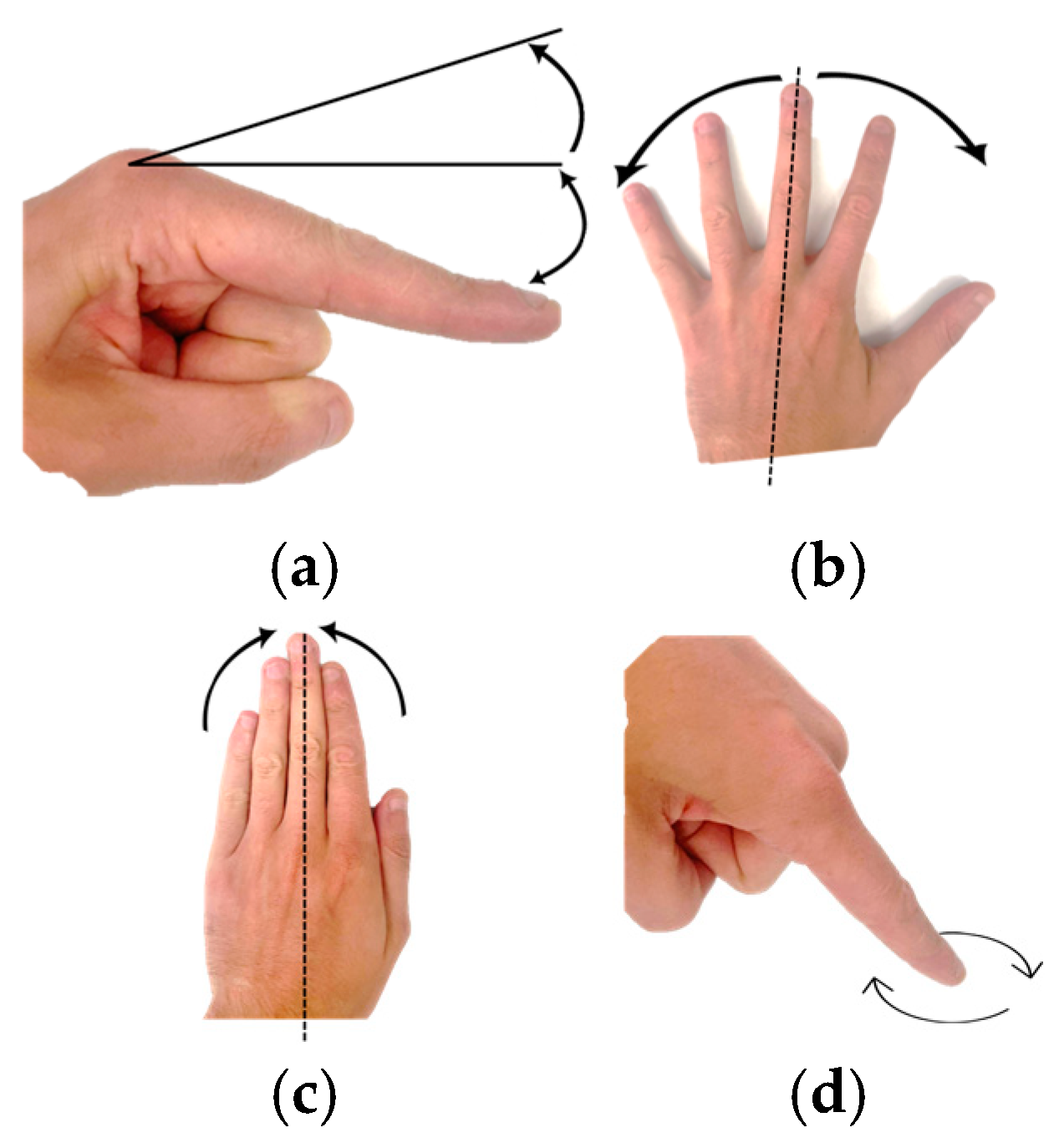
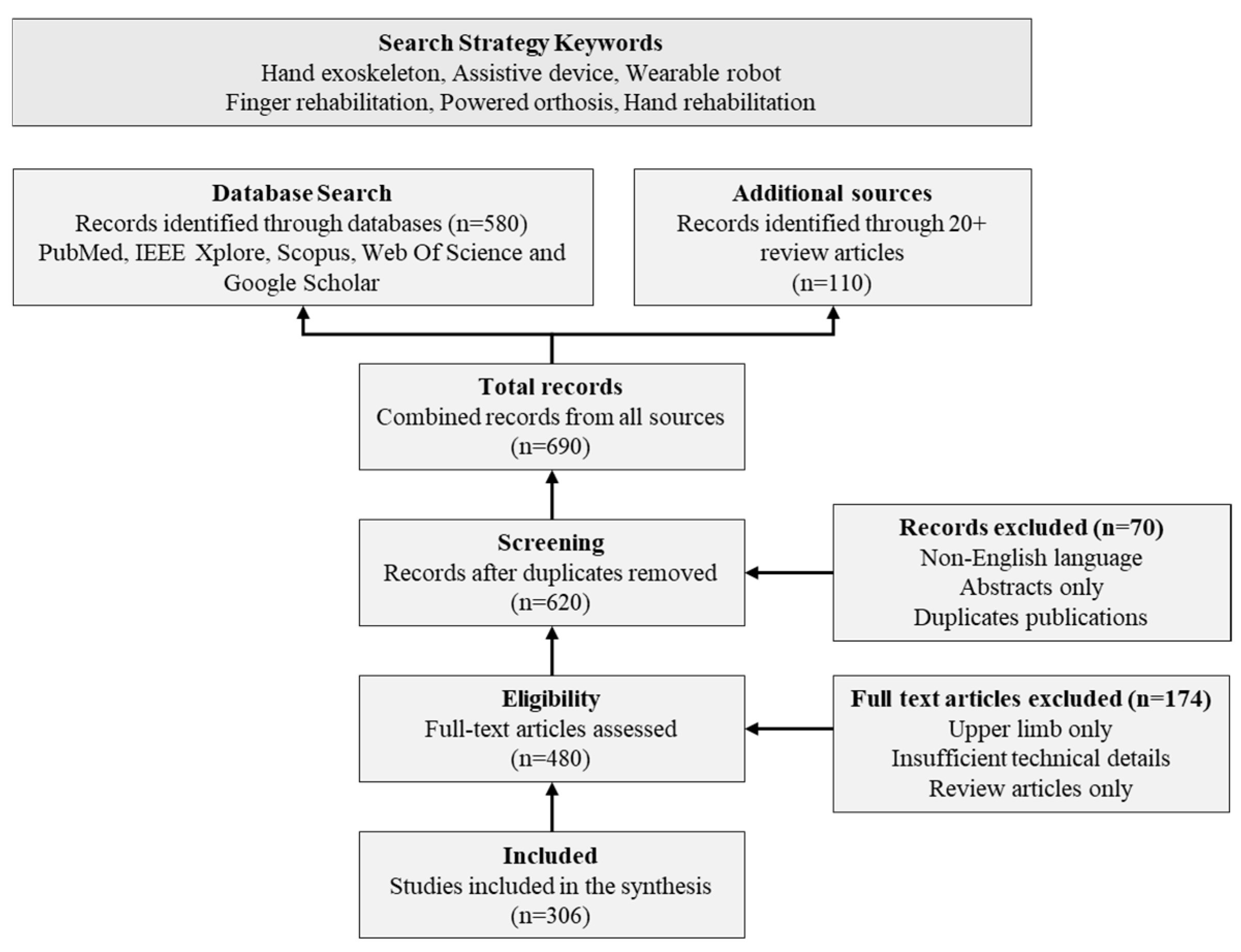
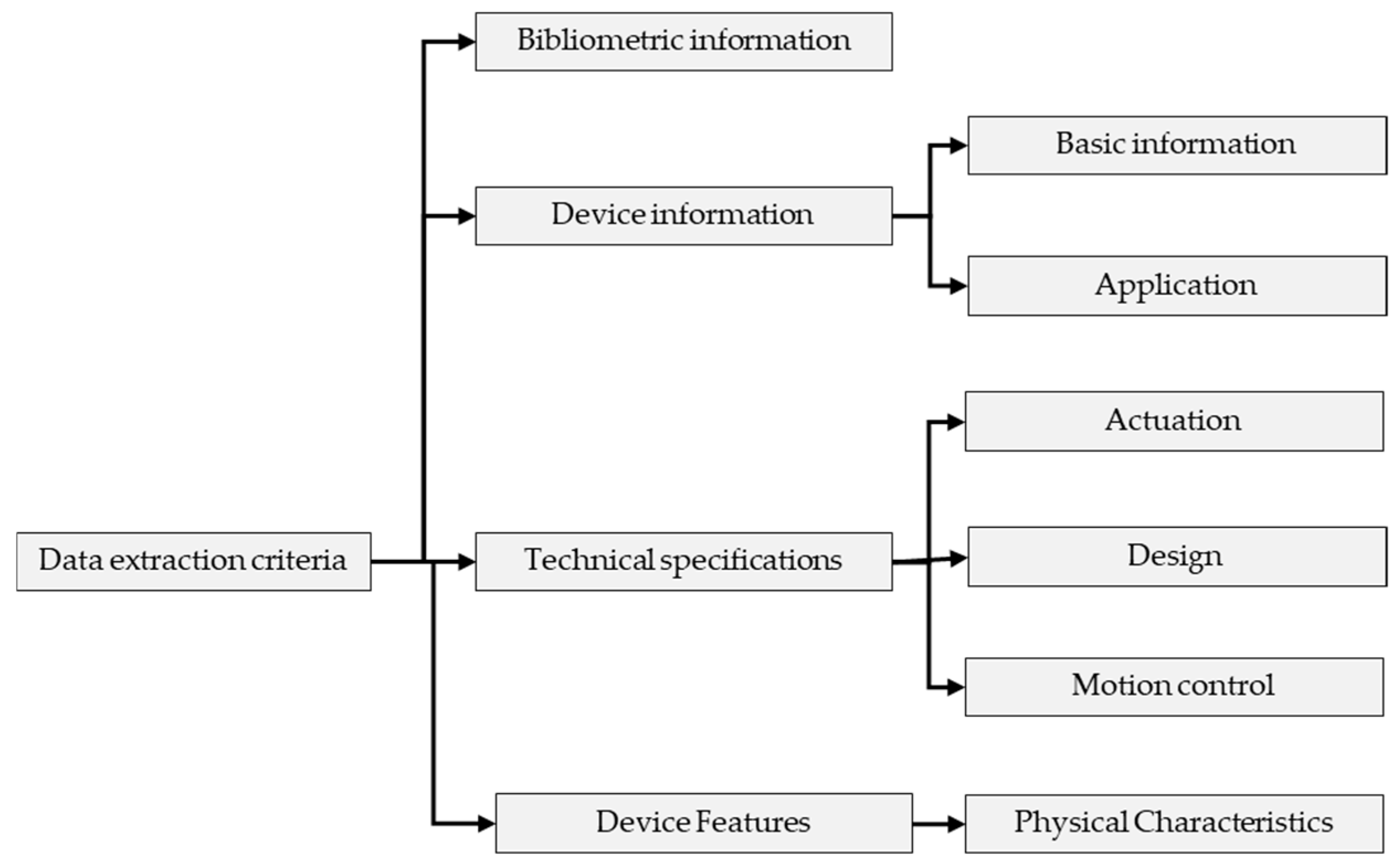

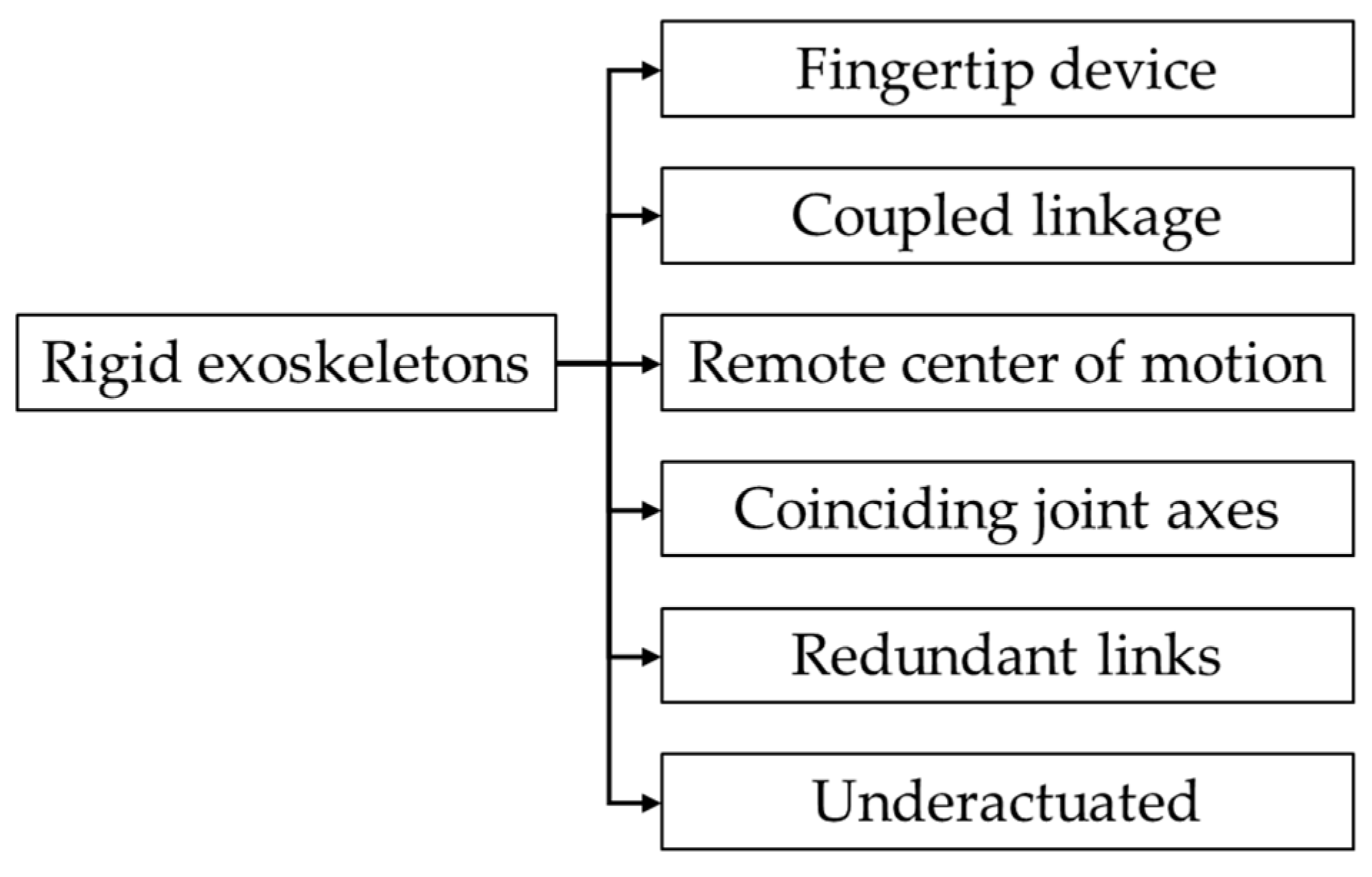
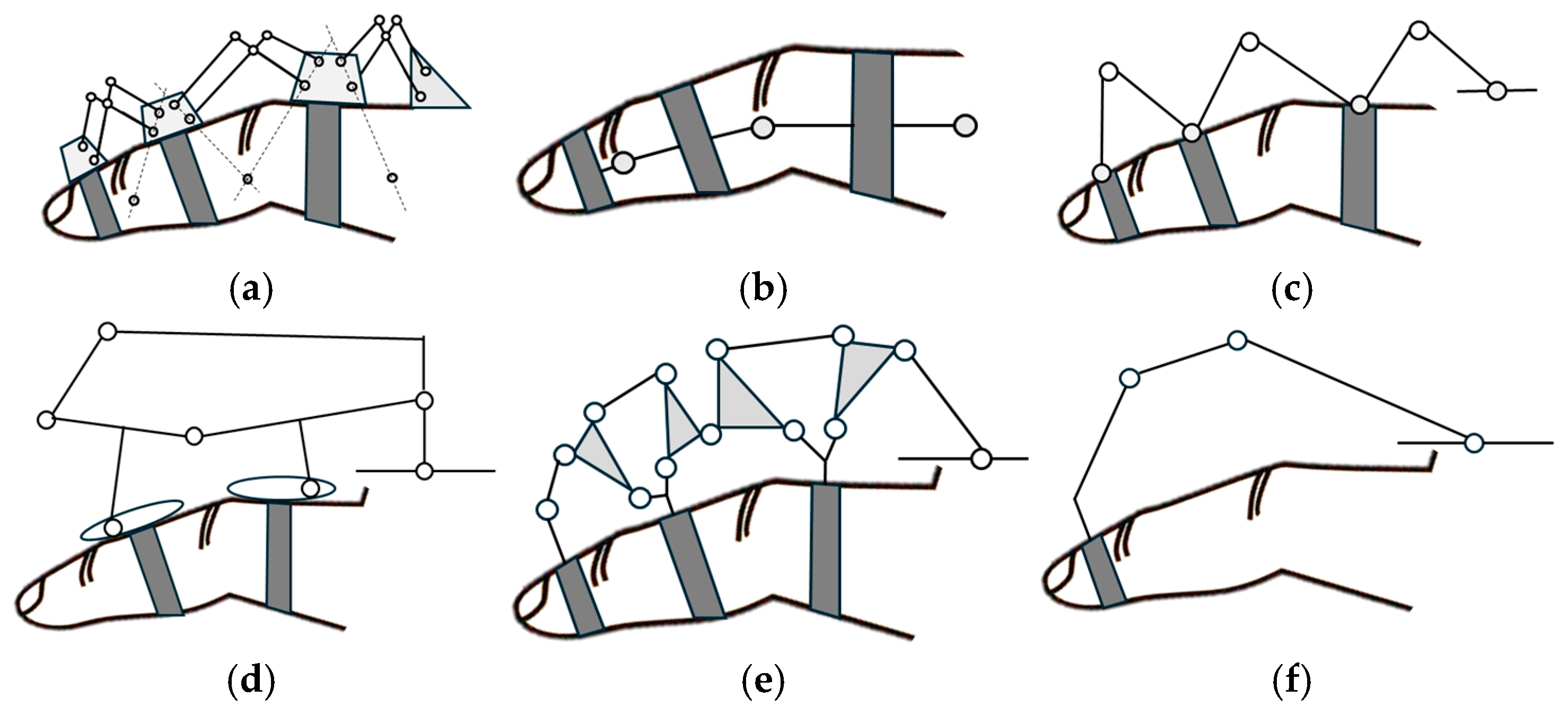



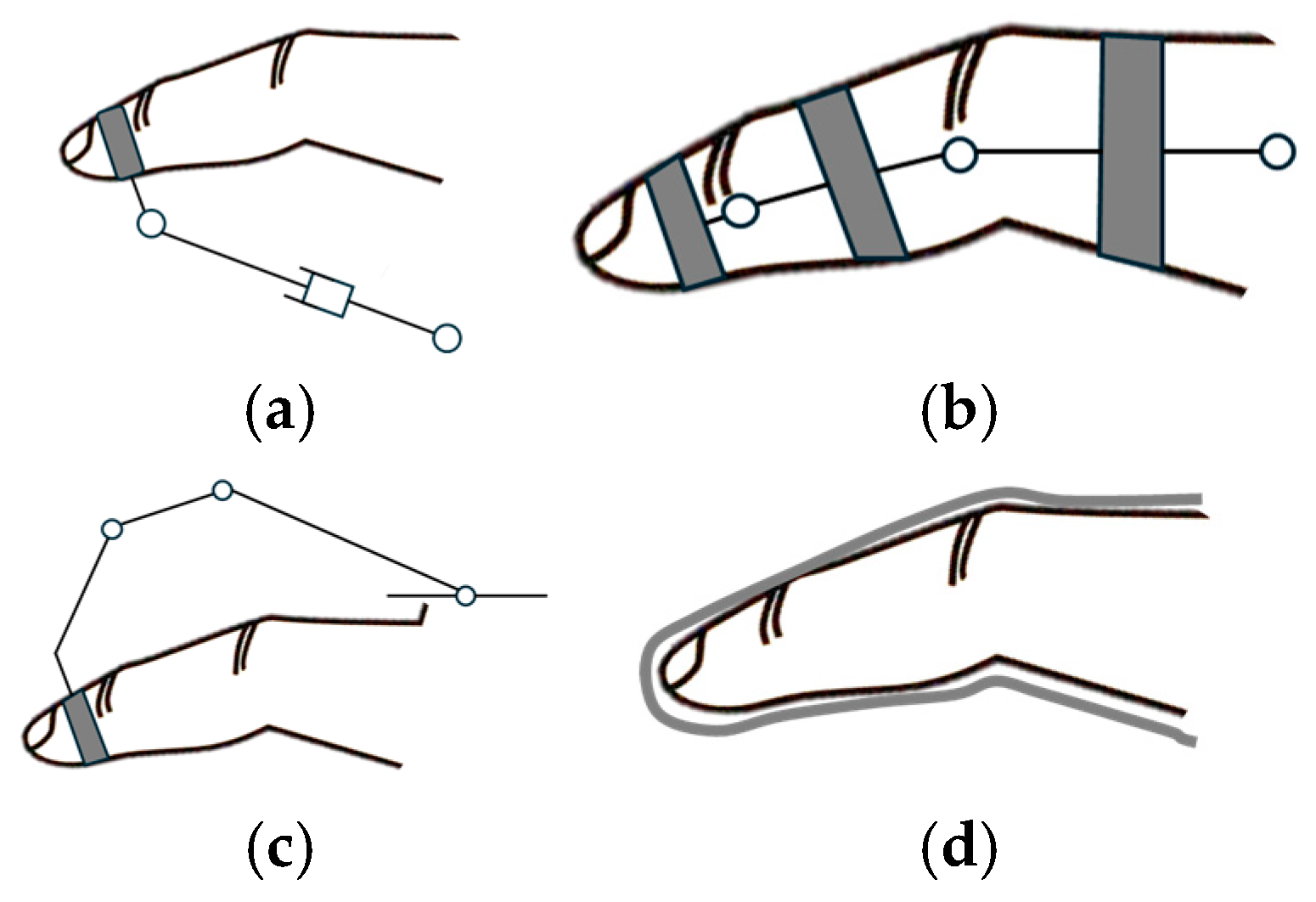
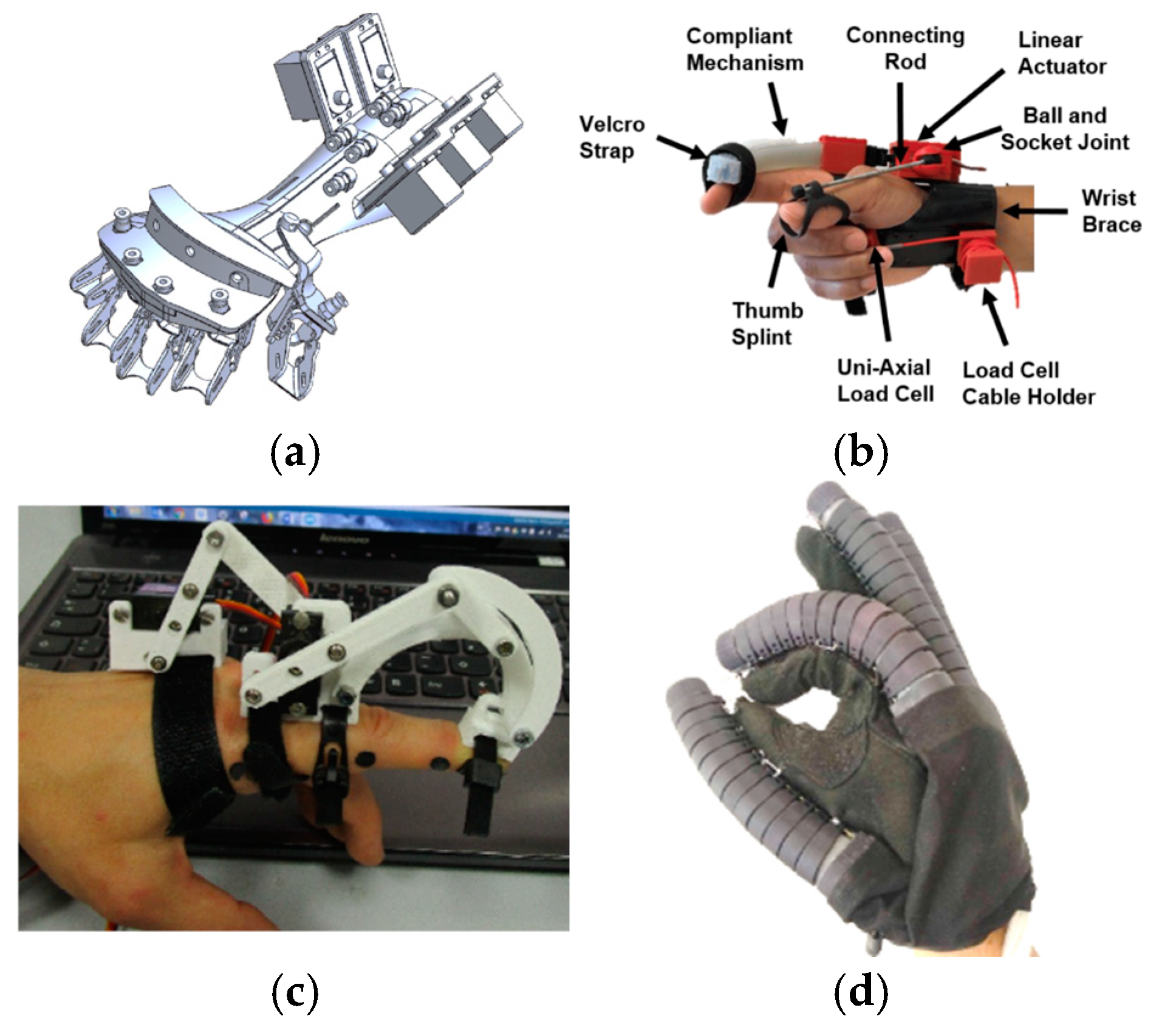
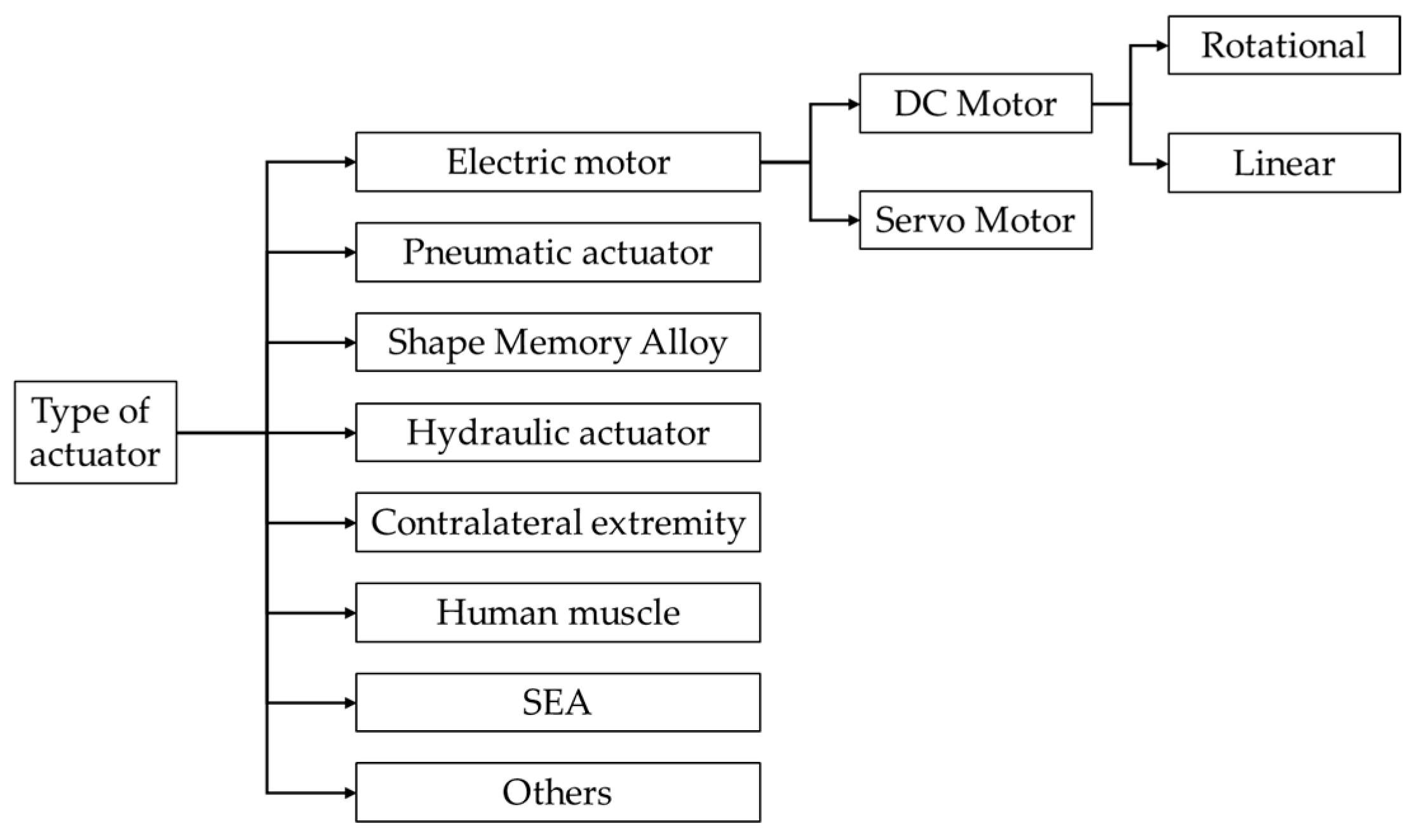
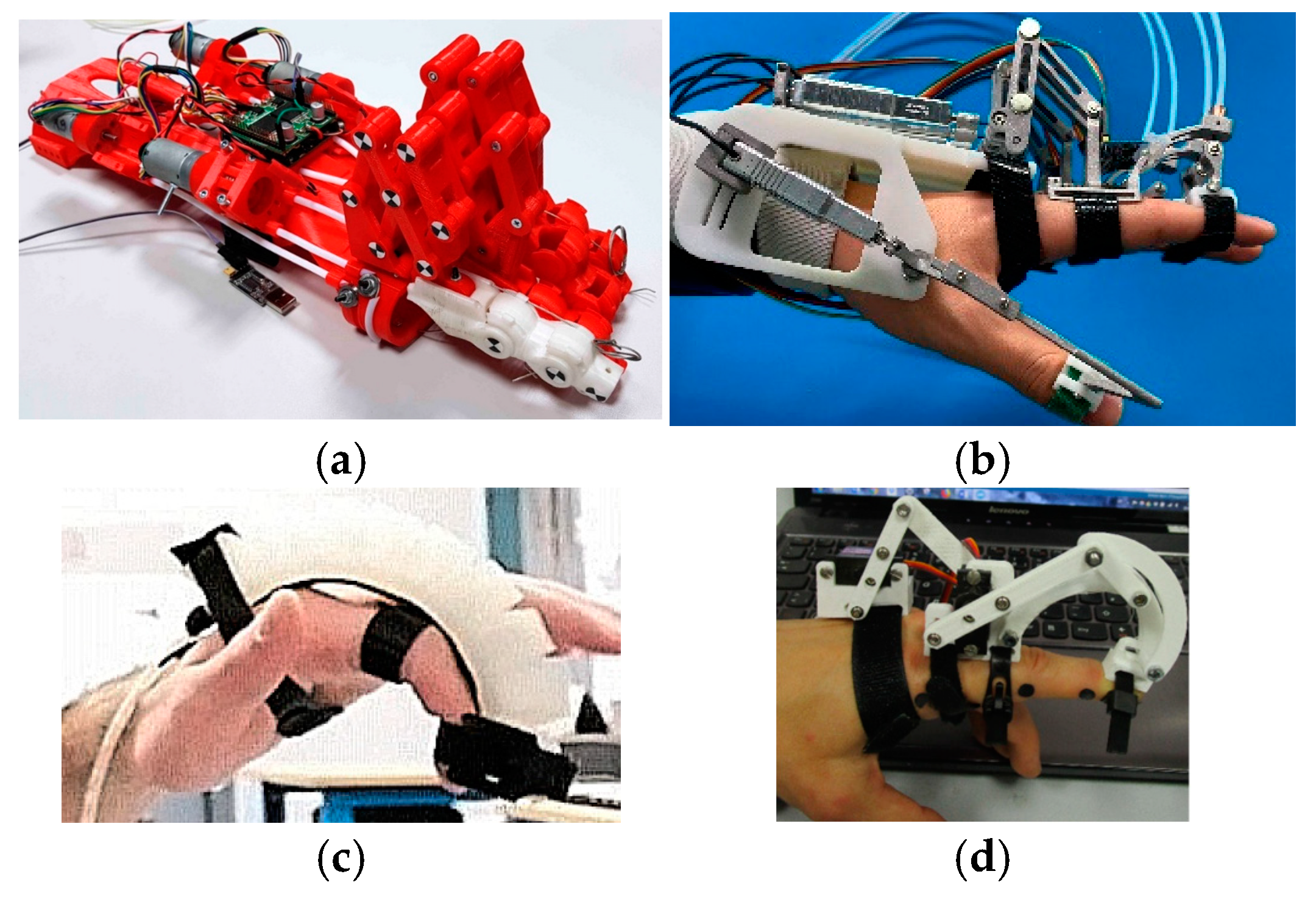



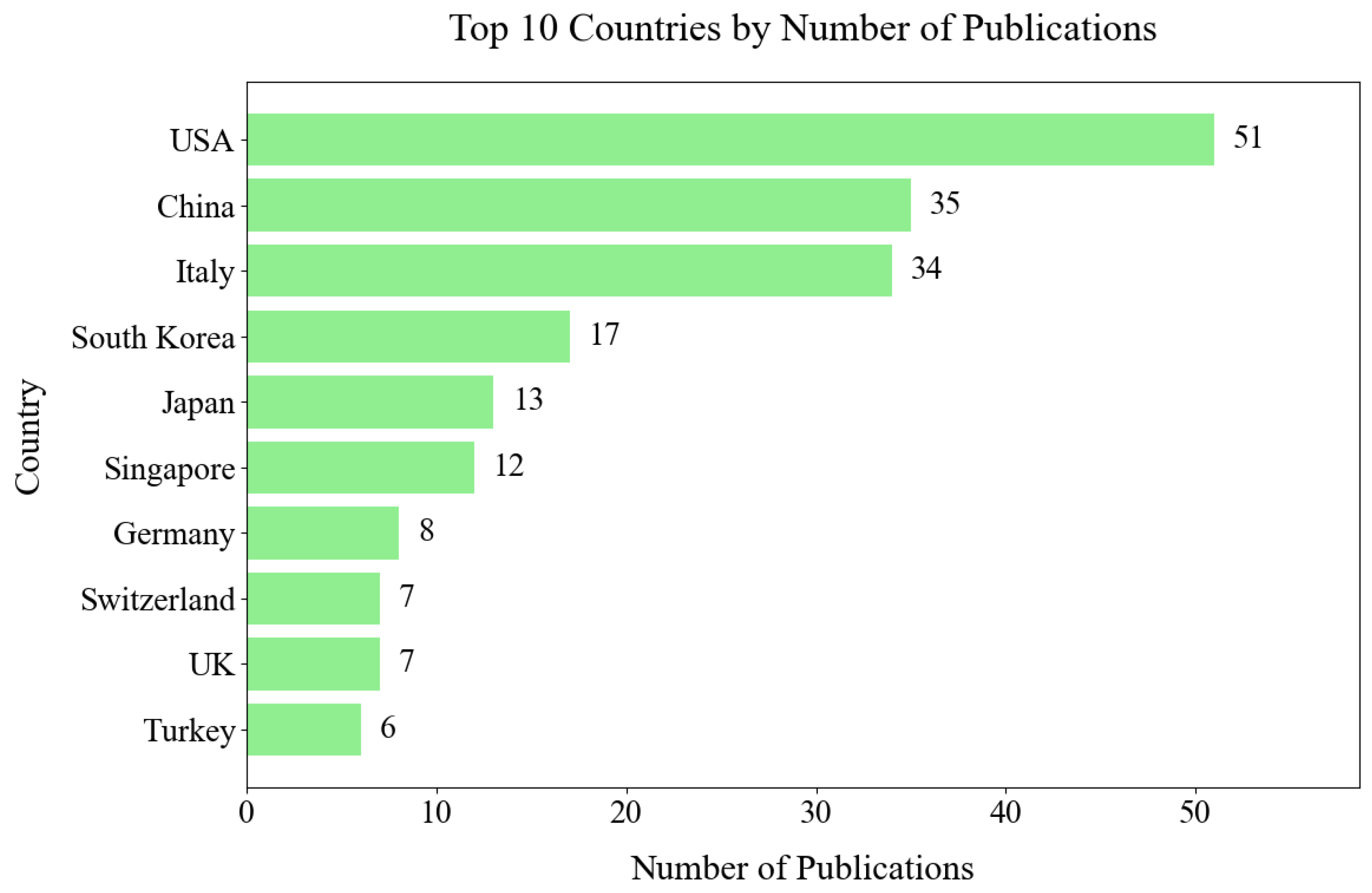


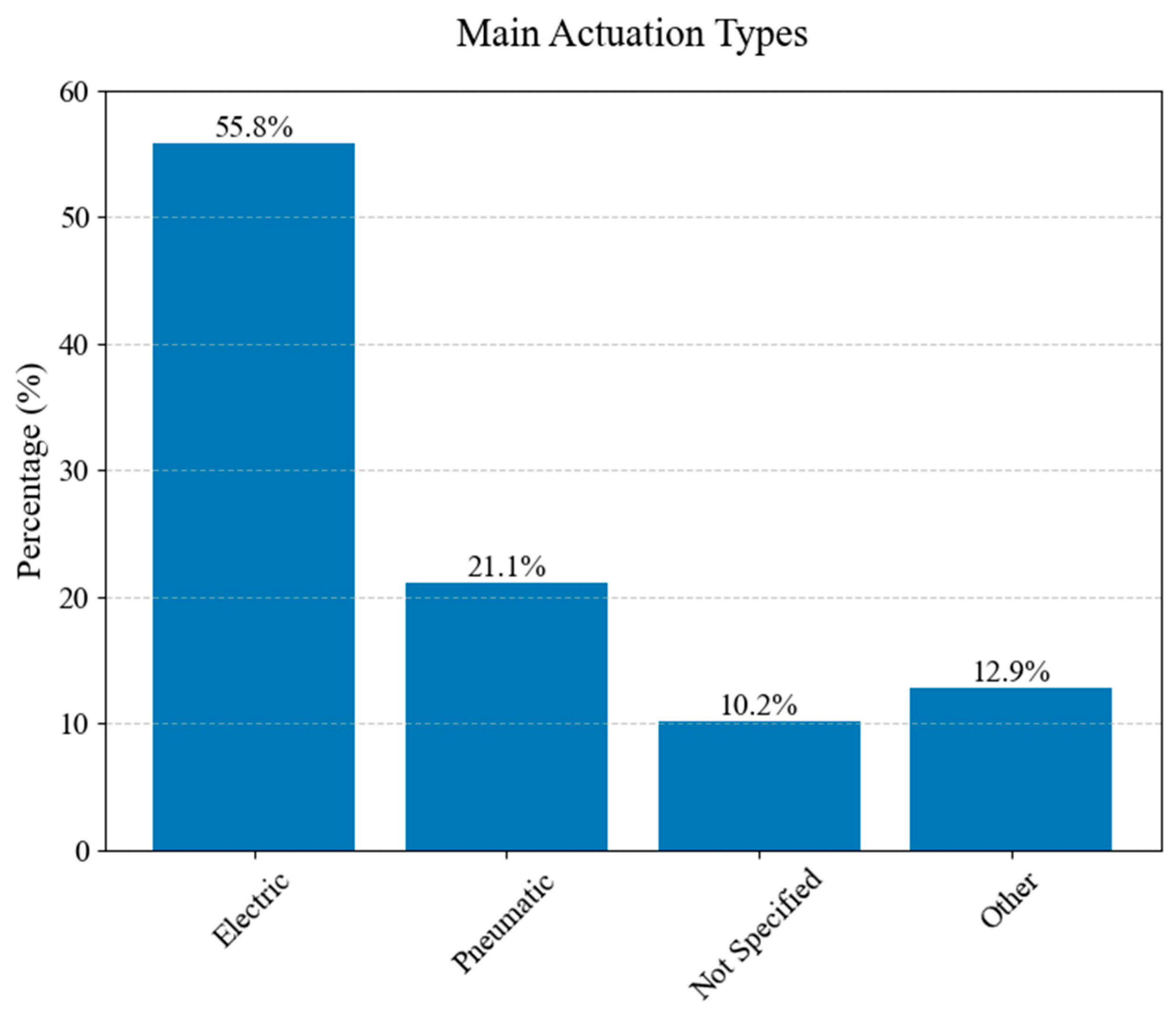
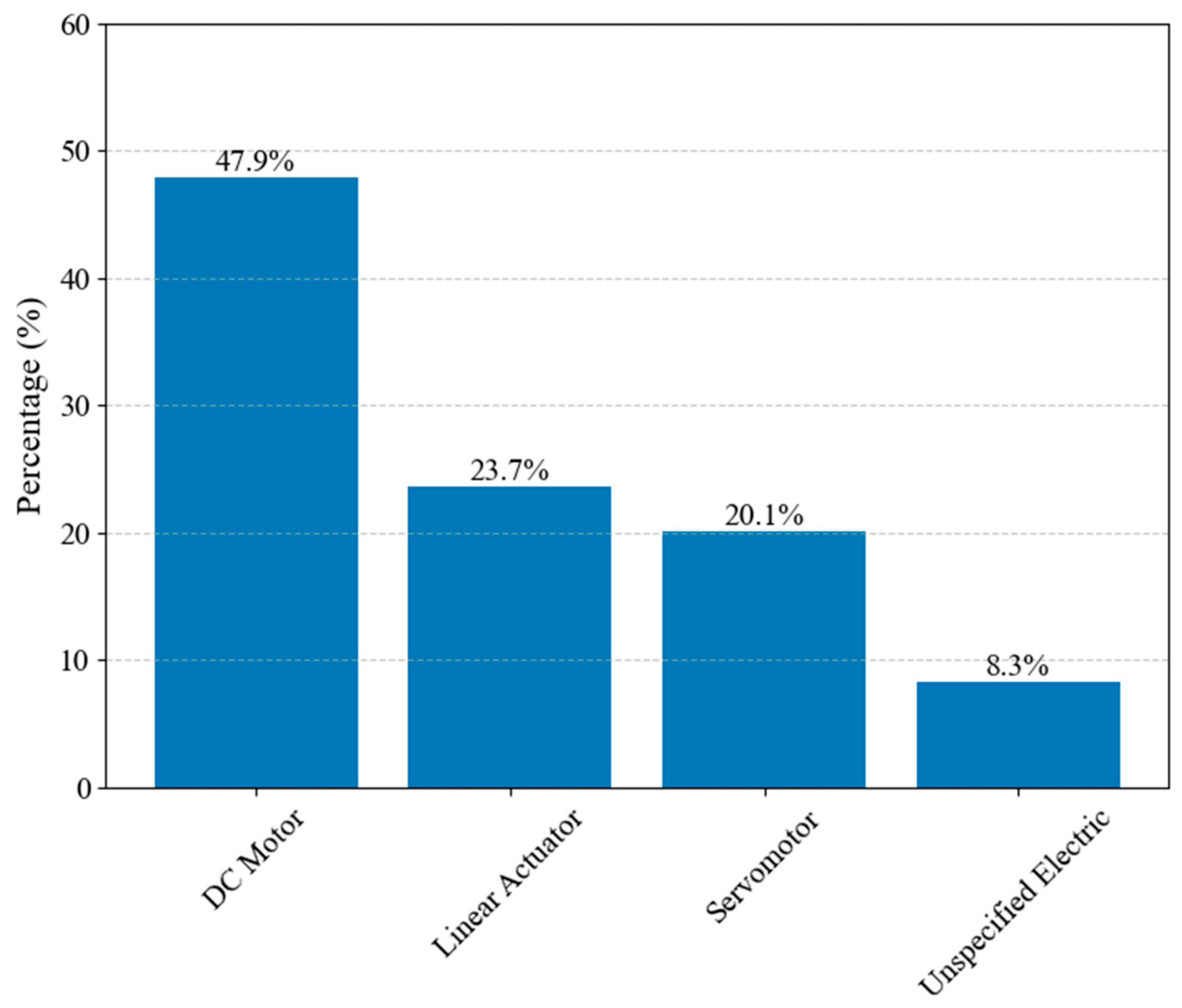



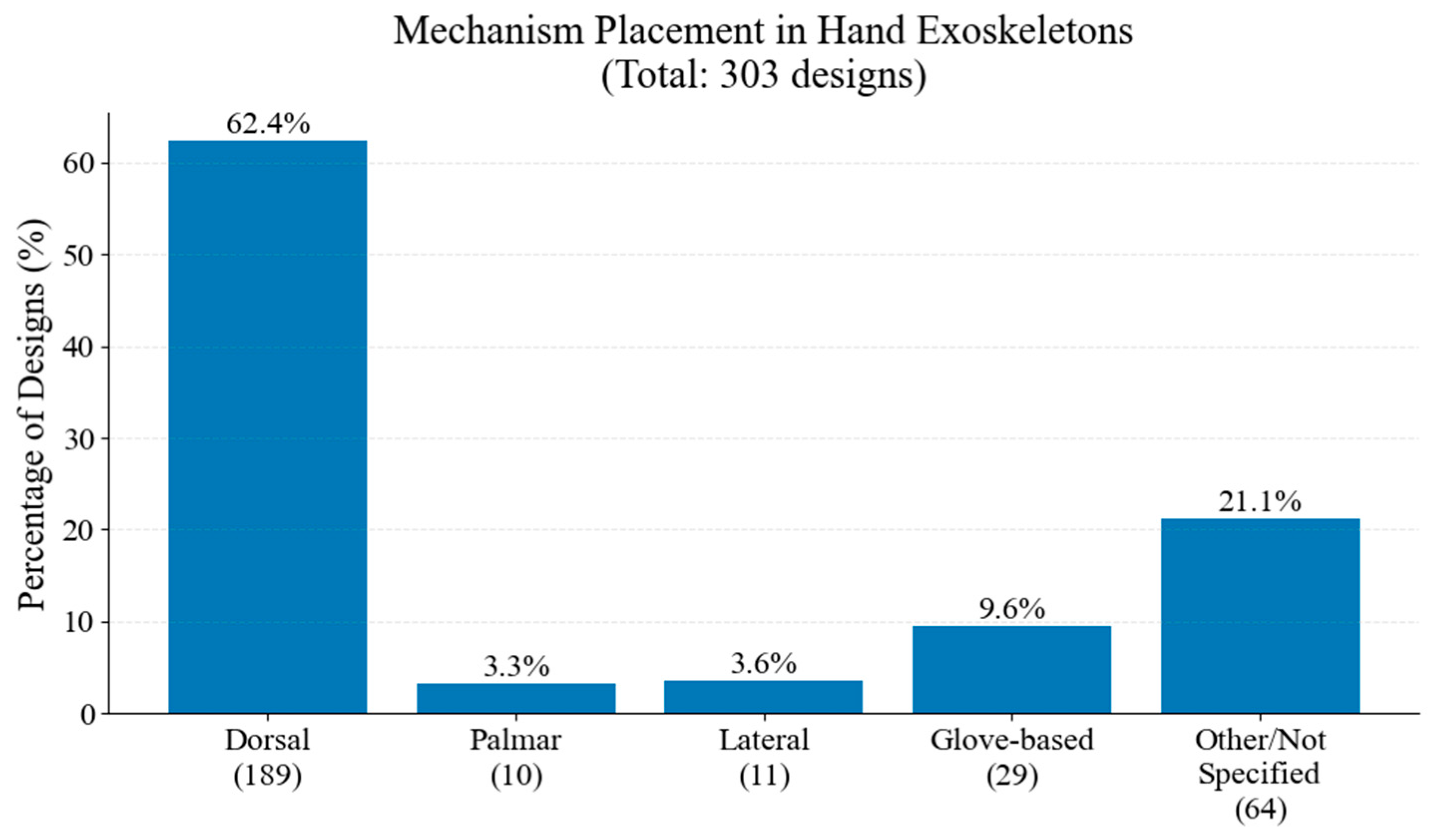



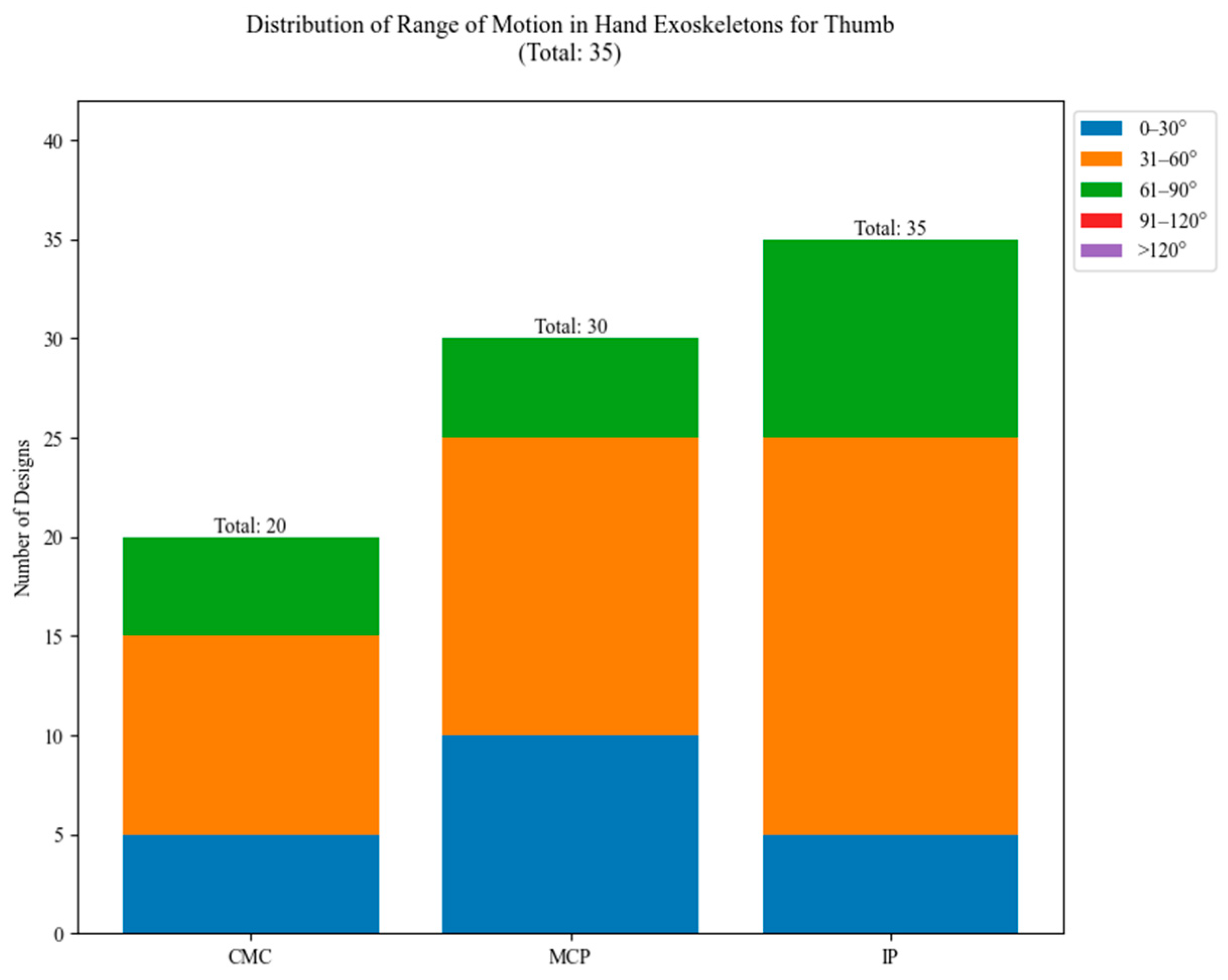
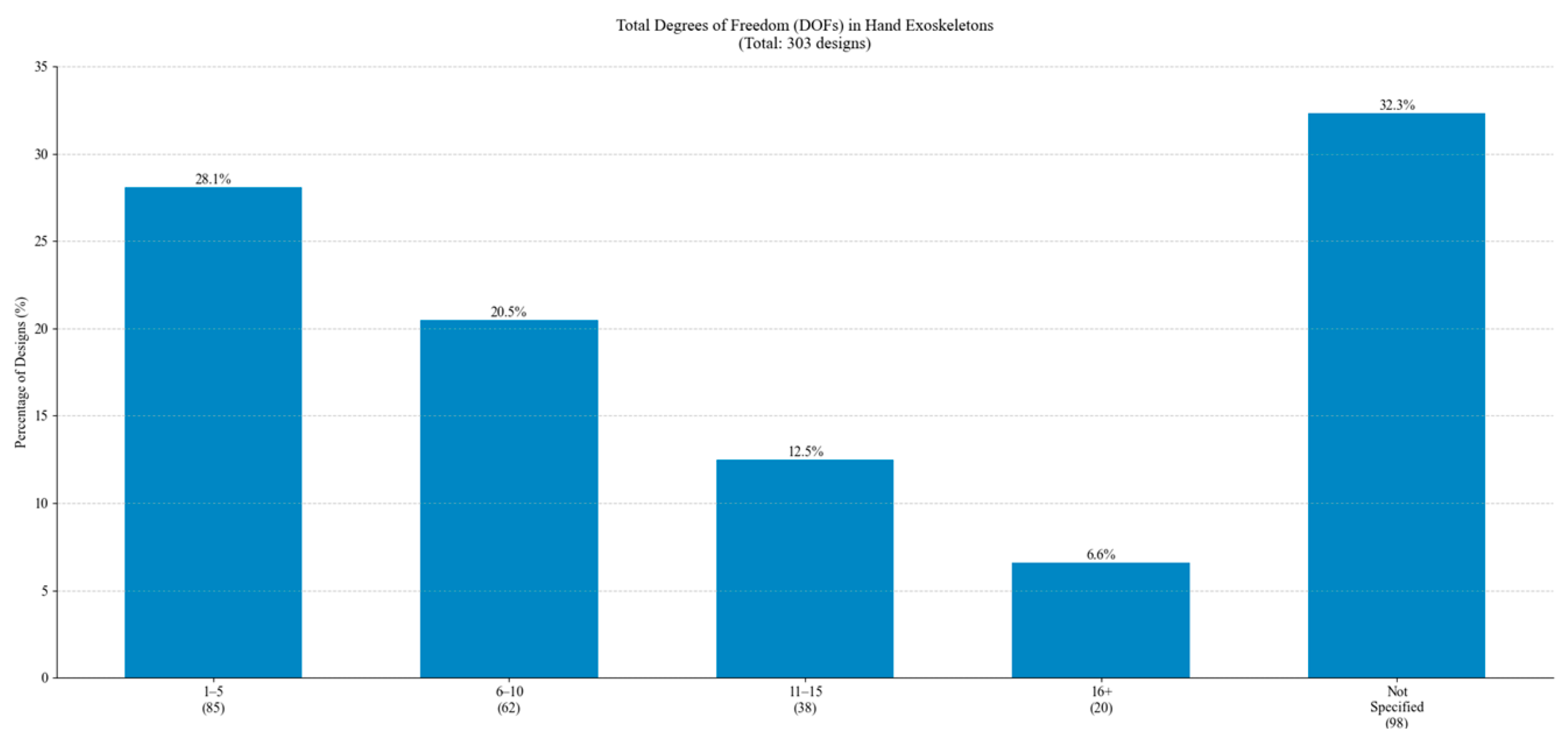
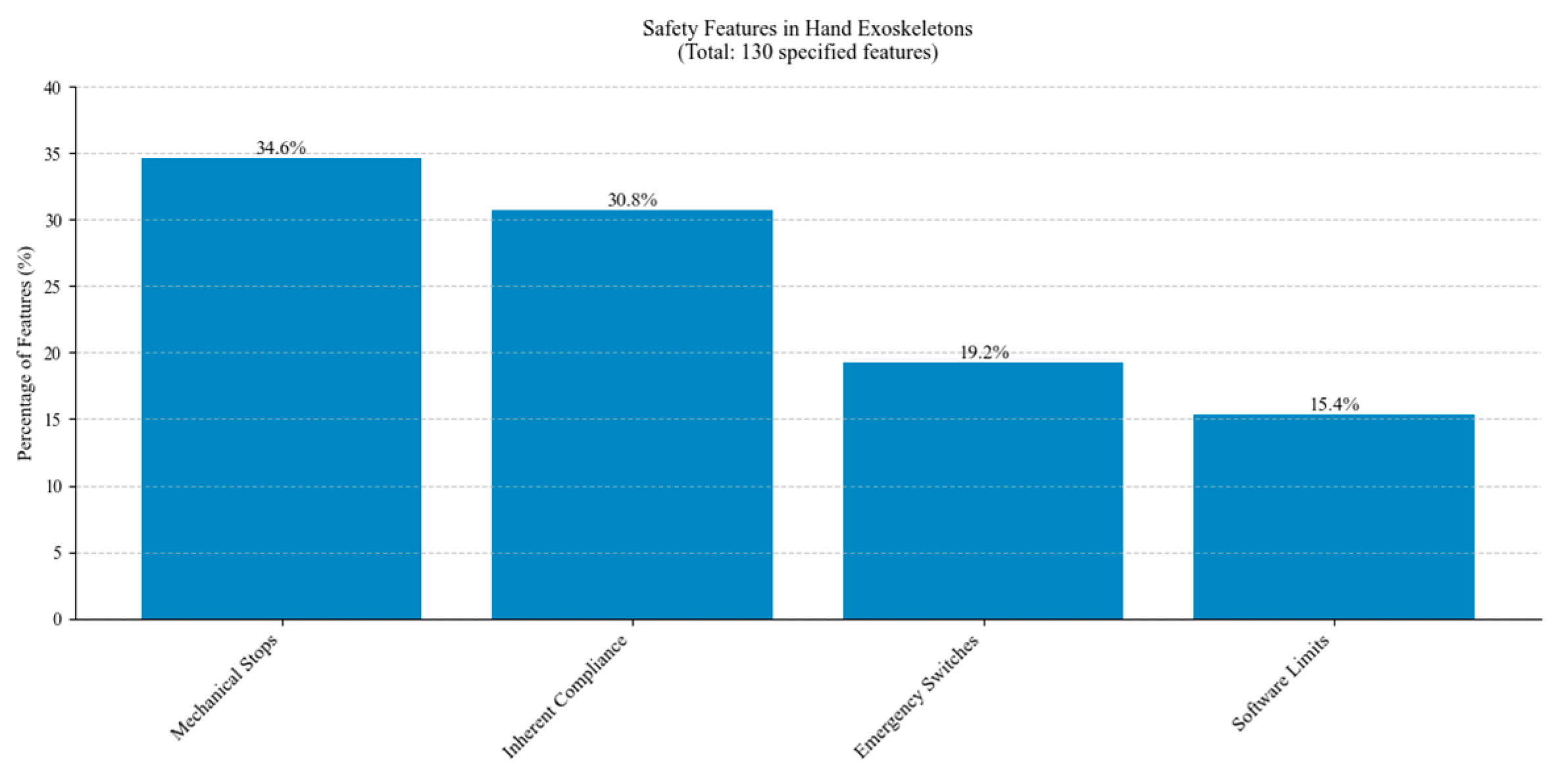



| Movement | Illustration of the Movement | Movement | Illustration of the Movement |
|---|---|---|---|
| Thumb up |  | Extension of index and middle, flexion of the other fingers |  |
| Flexion of ring and little finger extension of the other fingers |  | Flexion of fingers except thumb |  |
| Abduction of all fingers |  | Fingers flexed together in fist | 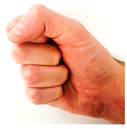 |
| Pointing index |  | Thumb opposing base of little finger |  |
| Grasping Movement | Illustration of the Grasping Movement | Grasping Movement | Illustration of the Grasping Movement |
|---|---|---|---|
| Large diameter grasp | 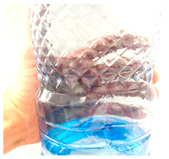 | Tripod Grasp |  |
| Small diameter grasp |  | Prismatic pinch grasp | 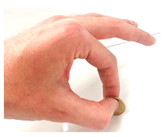 |
| Fixed hook grasp | 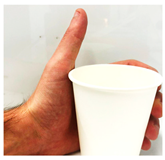 | Tip pinch grasp |  |
| Index finger extension grasp |  | Quadpod grasp | 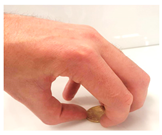 |
| Medium wrap | 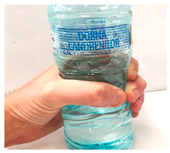 | Lateral grasp | 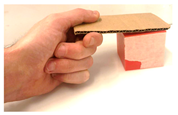 |
| Ring grasp |  | Parallel extension grasp | 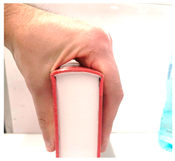 |
| Prismatic four fingers grasp |  | Extension type grasp | 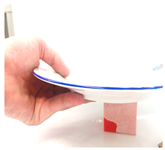 |
| Stick grasp | 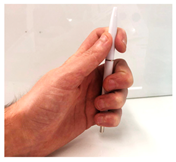 | Power disk grasp |  |
| Writing tripod grasp |  | Open a bottle with a tripod grasp |  |
Disclaimer/Publisher’s Note: The statements, opinions and data contained in all publications are solely those of the individual author(s) and contributor(s) and not of MDPI and/or the editor(s). MDPI and/or the editor(s) disclaim responsibility for any injury to people or property resulting from any ideas, methods, instructions or products referred to in the content. |
© 2025 by the authors. Licensee MDPI, Basel, Switzerland. This article is an open access article distributed under the terms and conditions of the Creative Commons Attribution (CC BY) license (https://creativecommons.org/licenses/by/4.0/).
Share and Cite
Gherman, B.; Zima, I.; Vaida, C.; Tucan, P.; Pisla, A.; Birlescu, I.; Machado, J.; Pisla, D. Robotic Systems for Hand Rehabilitation—Past, Present and Future. Technologies 2025, 13, 37. https://doi.org/10.3390/technologies13010037
Gherman B, Zima I, Vaida C, Tucan P, Pisla A, Birlescu I, Machado J, Pisla D. Robotic Systems for Hand Rehabilitation—Past, Present and Future. Technologies. 2025; 13(1):37. https://doi.org/10.3390/technologies13010037
Chicago/Turabian StyleGherman, Bogdan, Ionut Zima, Calin Vaida, Paul Tucan, Adrian Pisla, Iosif Birlescu, Jose Machado, and Doina Pisla. 2025. "Robotic Systems for Hand Rehabilitation—Past, Present and Future" Technologies 13, no. 1: 37. https://doi.org/10.3390/technologies13010037
APA StyleGherman, B., Zima, I., Vaida, C., Tucan, P., Pisla, A., Birlescu, I., Machado, J., & Pisla, D. (2025). Robotic Systems for Hand Rehabilitation—Past, Present and Future. Technologies, 13(1), 37. https://doi.org/10.3390/technologies13010037











